

Review of Trek Domane SL 5: Carbon Road Bike for Endurance Rides
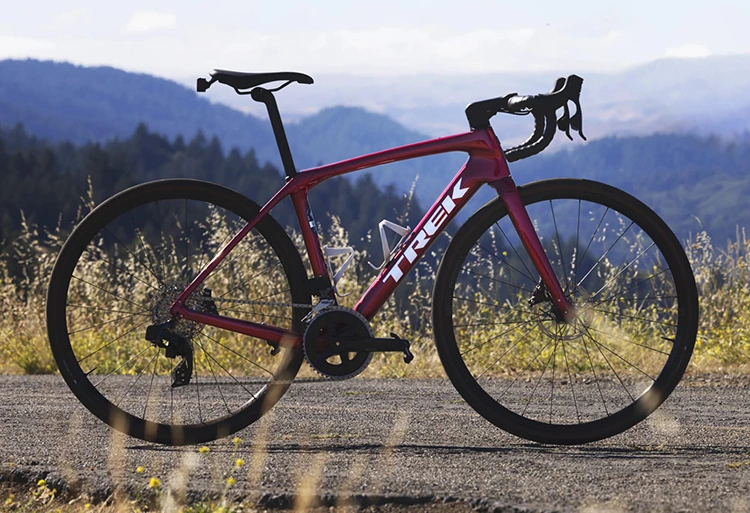
Trek Domane SL 5 is a step up from an entry-level carbon bike, featuring high-quality components and Trek’s patented IsoSpeed frame.
Trek’s Domane SL 5 carbon road bike features its unique 500 Series OCLV Carbon frame with front and rear IsoSpeed to absorb shock and reduce fatigue.
The IsoSpeed system is the result of years of research and development to create a frame with unprecedented comfort and maximum efficiency.
The Domane range of carbon road bikes is slightly heavier than typical carbon frame racing bikes due to the additional strength and comfort features.
These include thicker tires, heavier rims, and hydraulic brakes.
Trek Domane SL 5 Quick Overview
Main features, is the trek domane sl 5 the right choice for you, is it worth the money.
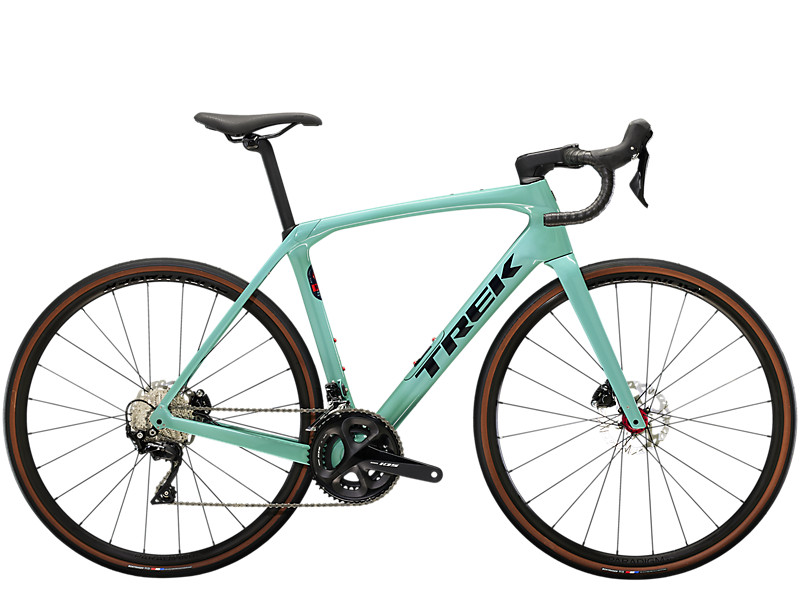
Trek Domane SL 5 Gen 4 is fitted with high-quality, lightweight components that complement its OCLV carbon frame.
This, coupled with IsoSpeed technology, makes for a surprisingly tight yet smooth ride.
- Frame : 500 Series OCLV Carbon IsoSpeed
- Fork : Domane SL tapered carbon steerer
- Front Derailleur : Shimano 105, R7000
- Rear Derailleur : Shimano 105, R7000
- Rims : Bontrager Affinity Disc Tubeless Ready
- Number of Gears : 22
- Brakes : Shimano SM-RT70
- Tires : Bontrager R3 Hard-Case Lite, aramid bead, 700x32c
- Weight : 19.69 lbs / 8.93 kg
Get From Trek
Rather than just a well-equipped carbon frame bike, the Domane SL 5 fits together specific features to create a light and comfortable road bike that can also tackle rough terrain.
The carbon IsoSpeed frame is supported by a Shimano 105 groupset and hydraulic disc brakes.
IsoSpeed carbon frame
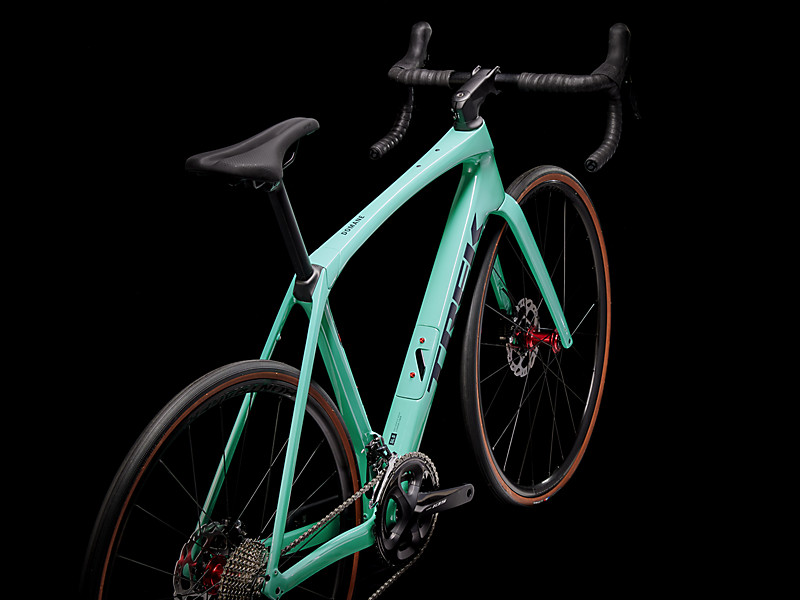
Trek’s IsoSpeed system features front and back decouplers with a rocker cup that allows flex in the seat tube and steerer tube.
This helps to provide a smooth ride without losing solid road contact and stability.
The frame uses optimized endurance geometry to give the rider a confident, controlled feeling in the saddle.
When it comes to carbon frames, its 500 Series OCLV is on the heavier side which is most noticeable on hills. However, it makes up for this but cutting through bumpy surfaces with ease.
Performance Cable Routing
The rear gearing and brake cables are internally routed through the bike’s carbon body, keeping the frame neat and clean.
This not only protects the cables but makes everything more attractive and aerodynamic.
Unfortunately, the front disc brake cabling is not routed through the fork, leaving a rather untidy zip-tie solution running down the left fork.
An odd choice for a road bike in this price range but it works just as well, albeit a bit less easy on the eye.
Shimano 105 groupset
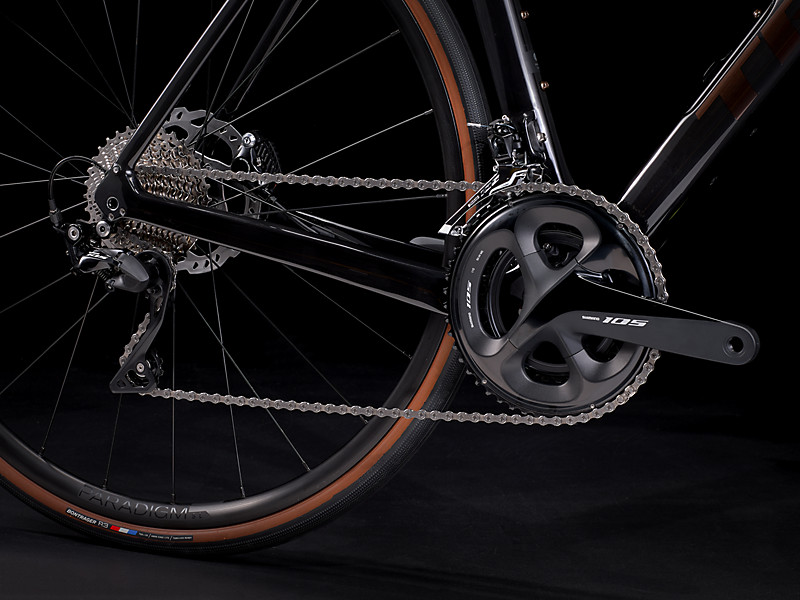
Trek’s decision to use Shimano’s 105 groupset for the Domane SL 5 was an excellent choice and suits its high-quality carbon frame.
The complete Shimano groupset includes the shifters, chain, hydraulic brakes, front and rear derailleurs, and an 11-speed cassette.
The complete set works together to provide excellent, fault-proof mechanics and seamless operation that lets you focus on the road ahead.
Shimano 105 is one of the most reliable drivechains available and has been a firm favorite of cyclists around the world for decades.
The Domane SL 5 incorporates Bontrager Paradigm rims for their strong, durable nature.
Wrapped around the Domane SL 5’s Paradigm rims are Bontrager R3 Hard-Case Lite 700x32c tires.
The extra-large tires are an unusual choice for a carbon road bike, further solidifying its purpose as an all-terrain machine.
Endurance geometry
The endurance geometry used in the Domane range of road bikes is designed for long-distance rides, with a slightly higher headtube.
It attempts to balance speed and comfort, providing a more relaxed seating position than is commonly found on carbon racing bikes.
The sloping top tube reaches the seat post at an angle that makes it appear to move almost continuously into the seatstays.
The thicker-than-usual downtube also has an ever-so-slight bend that creates an appealing profile view.
It’s a marriage of technical perfection and high-quality materials to deliver a truly unique carbon frameset.
The Trek Domane SL 5 comes in 9 different sizes to fit heights of 4’11 to 6’2.
- 44 : 4’11” – 5’0″
- 47 : 5’0″ – 5’2″
- 50 : 5’2″ – 5’4″
- 52 : 5’4″ – 5’6″
- 54 : 5’6″ – 5’9″
- 56 : 5’9″ – 5’11”
- 58 : 5’11” – 6’1″
- 60 : 6’1″ – 6’3″
- 62 : 6’3″ – 6’5″
Trek’s Domane SL 5 is a serious carbon-framed road bike for dedicated riders looking to cover long distances on a regular basis.
It would suit semi-professional cyclists and triathletes looking to train regularly for competitions and events.
Sure, if you’re just a weekend rider and can afford it, you’ll love it.
However, a bike of this quality deserves to be put through its paces by those aiming for the podium.
It’s tough, fast, comparatively light, and most importantly: it provides a beautifully smooth ride.
Check out our other reviews on Domane AL 2 , AL3 , SL4 and SL6 .
Related: Trek Bikes Explained – In-Depth Overview
High-quality carbon frame: check.

High-quality Shimano components: check.
A price tag under $3,500: check.
I would say, yes, the Trek Domane SL 5 is most certainly a piece of equipment that ticks all the right boxes to offer excellent value for money.
There are faster and lighter carbon road bikes in a similar price range, and there are tougher bikes too, but none of them find the balance quite as well as the Trek Domane SL 5 does.
This is a long-lasting bike that will seldom require any repairs or upgrades.
Related Topics:
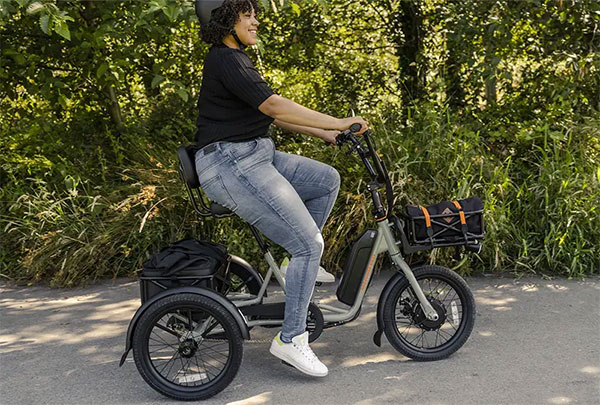
Rad Power Bikes RadTrike Review: A Feature-Rich Electric Tricycle
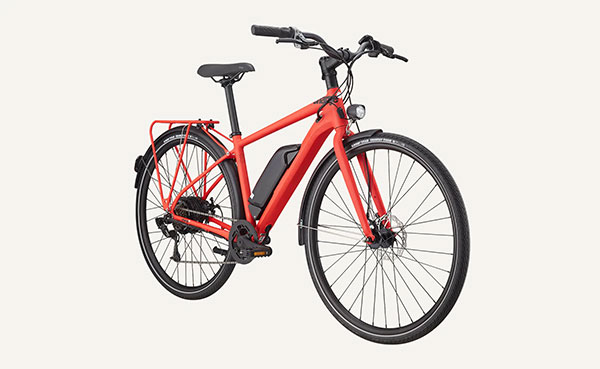
Charge City Electric Bike Review: Practical, Elegant, and Made for Urban Dwellers

Aventon Level.2 Review: A Reasonably Priced Fully Equipped Commuter
Leave a reply cancel reply.
Your email address will not be published. Required fields are marked *
Gear-obsessed editors choose every product we review. We may earn commission if you buy from a link. How we test gear.
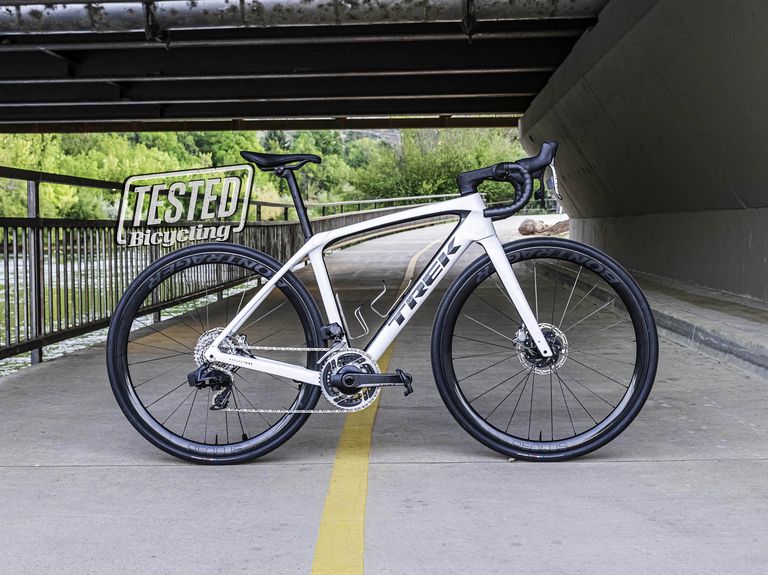
The New Trek Domane: A Great Bike Made Better
The new Domane is everything great about the old bike, plus lighter and quicker.
The Takeaway: Trek’s best road bike gets faster, lighter, quicker, and better
- Frames are 300 grams lighter
- Slight aerodynamic improvements
- Compatible with any bar and stem
Price: $3,500 (SL 5) to $13,200 (SLR 9 eTap, tested) Weight: 19.7lb. (SL 5) to 16 lb. (SLR 9) 16.8 lb. as tested (SLR 9 eTap 52cm)
Trek Domane MK.4 Gallery
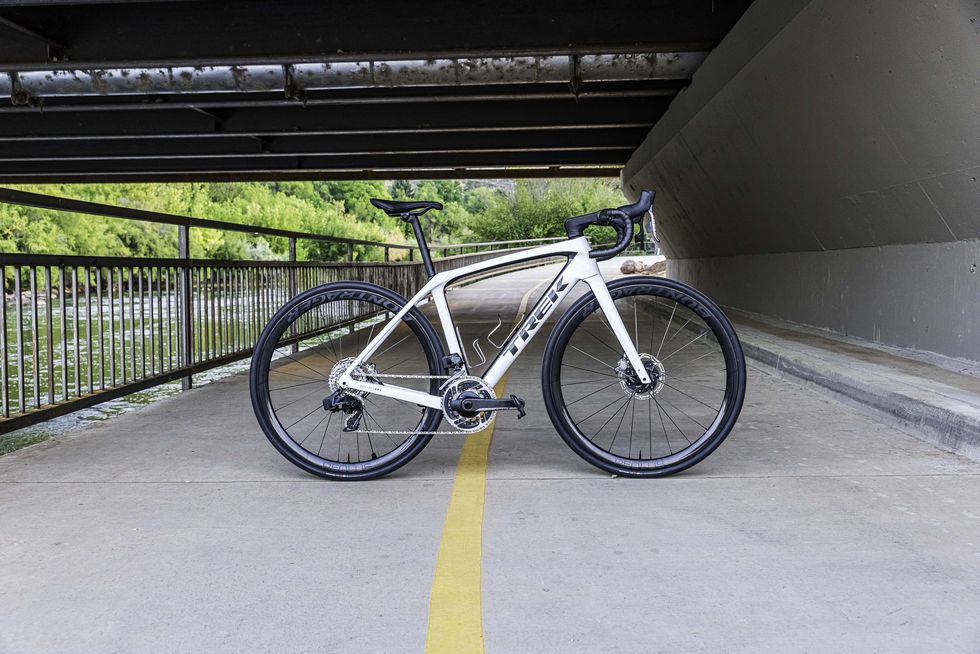
Trek Domane Generation Four—What is New
My biggest knock against the third-generation Domane was the weight. It was an excellent and feature-rich bike but a little hefty. So, I am happy to report that one of the most significant changes to the fourth generation frame is it is lighter by about 300 grams (more than half a pound. A large part of the weight savings came from simplifying the bike’s signature rear IsoSpeed Decoupler and eliminating the IsoSpeed Front system that debuted in the previous generation Domane.
When asked why Trek eliminated IsoSpeed Front, Jordan Roessingh, director of road bikes, stated that much of the system's benefit—which never offered the same compliance improvement as rear IsoSpeed—was made redundant by riders' increased adoption of higher volume tubeless tires run at lower pressures. Combined with the system’s weight penalty, Trek decided the juice was not worth the squeeze and punted IsoSpeed front into the dustbin of history.
Meanwhile, at the rear, Trek removed the adjustment from the SLR’s top tube IsoSpeed. All frames now have fixed compliance. Reggie Lund, a design engineer at Trek, said that it found, “A lot of our riders were never taking advantage of the adjustability on the previous generation bike,” so they decided to remove the feature which simplified and lighted the frame. Roessingh stated that the new Domane’s fixed compliance is in line with the previous generation SLR’s IsoSpeed set to the most compliant position.
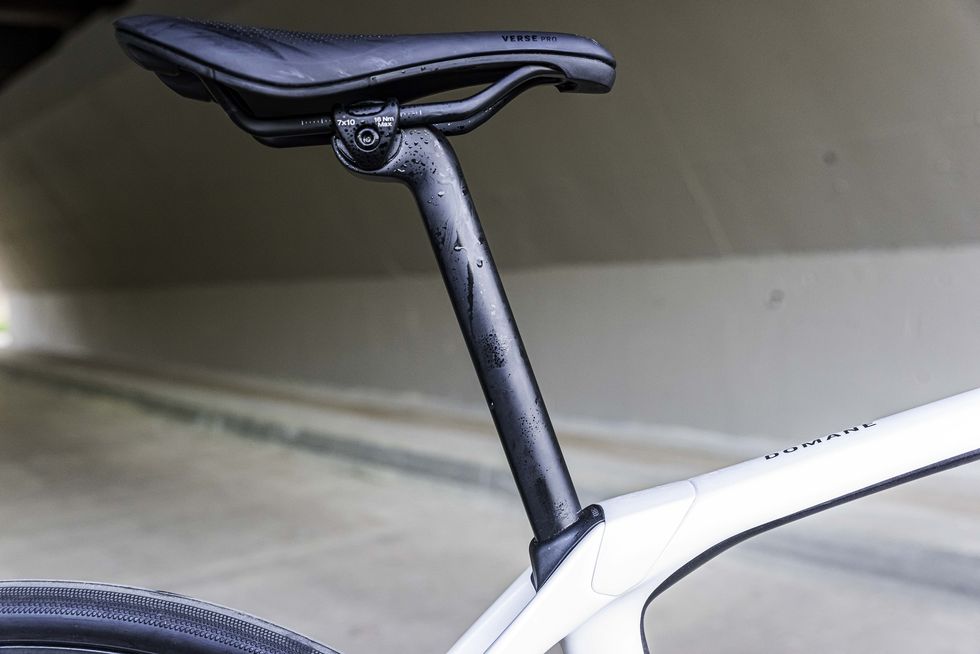
SL-level frames also see a change to their rear IsoSpeed system. Trek has multiple iterations and generations of IsoSpeed. While third-generation Domane SLR frames had adjustable top tube IsoSpeed, third-generation Domane SL frames had non-adjustable seat tube IsoSpeed. SL and SLR fourth generation Domanes get the new non-adjustable top tube IsoSpeed.
Roessingh said that one of the drawbacks of the third-gen Domane’s non-adjustable seat tube IsoSpeed was that the system got more rigid as the seat tubes got shorter. In short, smaller and likely lighter riders experienced a rougher ride than larger riders. Top tube IsoSpeed eliminates this compromise and lets Trek tune compliance per frame size, said Rosseingh, so all riders experience similar levels of comfort.
Another signature feature of carbon framed Domane models that went to the dustbin was Trek’s No Cut semi-integrated seat mast. Instead, all models now use a seat post, although a proprietary D-shaped post instead of being round. Thankfully, Trek offers two lengths (280 and 320mm) and two offsets (five and 20mm) to help riders dial in fit. The seatpost clamp hides under a snap-on cover on the top tube, which helps clean up the lines of the new Domane.
Another way Trek cleaned up the Domane’s appearance is with a new stem with a cap that hides the hoses and housing before they enter the frame through the upper headset cover. But while the bike appears to have fully integrated routing, you can swap stem lengths without pulling the hoses or housing. The bike is compatible with a standard handlebar, and riders can use standard stems. However, if you want to install a standard stem, you will need to acquire a different upper headset cover from Trek, and you will probably want to zip-tie your hoses and housing together underneath the stem.
Trek’s Domane stem comes in sizes 60 to 130mm in minus-seven degree rise and 60 to 100mm in plus-seven degree rise. The faceplate features a single bolt mount for a computer/light/camera. Unfortunately, the Domane stem’s one-bolt mounting standard is different from Trek’s one-bolt mounting system for the Madone and Emonda and also different than any of the other stems with this feature (3T, Cervelo, Fizik, Specialized, Felt, Easton).

Trek also states that the new Domane is more aerodynamic than the previous generation due to the updated shape of the fork, downtube, seat tube, seat stays, and more-integrated cables in the front. However, Trek did not provide any data on the aerodynamic improvements. When I asked Roessingh for time or watt improvements, he told me, “I don’t think we have a specific claim other than saying we do know the bike is faster. But it’s not a huge amount so it’s not a claim we’re labeling as one of the headlines of the launch.”
One small new feature added to the Domane is a mount in the top tube for a feed bag. What has not changed is the Domane has clearance for up to a 38mm tire, hidden fender mounts, the threaded (T47) bottom bracket, and the in-frame storage accessed through the hatch in the downtube.
SL and SLR frames are compatible with mechanical drivetrains. But, there is a catch outlined in Trek’s FAQ, “The frame does not have a front derailleur housing stop, which means that you are limited to front derailleurs with a built-in stop, like Shimano toggle front derailleurs.” That means the frame is not compatible with SRAM or Campagnolo mechanical-shift drivetrains.
Trek Domane Four—SL Versus SLR
There are two grades of Domane frame: SL and SLR. According to Roessingh, “SL and SLR are essentially identical from a feature set perspective and frame shape perspective.” The biggest difference is the carbon: The SL uses Trek’s “500 Series” carbon while the SLR uses “800 series” carbon. That material difference results in a 200-300 gram reduction in frame weight. According to Trek, this puts the SL frameset at 2,500 grams and the SLR frameset around 2,200 grams.
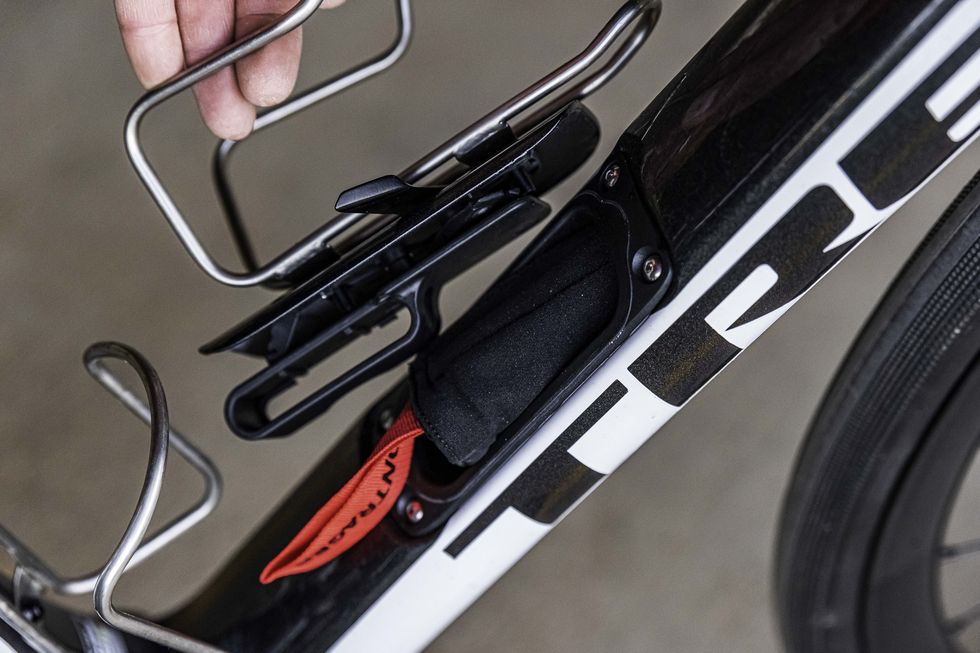
Trek Domane Four—RSL for the Racers
Although Trek’s professional racers ride a Domane in some events, typically the cobbled classics, they do not ride the standard frame. Instead, they use the Domane RSL (Race Shop Limited). It is the frame ridden to victory in the 2022 Paris-Roubaix Femmes by Elisa Longo Borghini , and it has a few notable differences from the mainline frame.
The primary distinction is fit. The RSL fame is much lower and longer than the SL and SLR Domane. Using a 56cm frame as an example the RSL’s reach is 21mm longer (395 versus 347mm) while the stack is 43mm shorter (548 versus 591mm). The RSL also has a much shorter trail length (51mm compared to 61), likely because of the increased weight the RSL’s geometry places on the front wheel.
Other changes include eliminating the top tube bag mounts and in-frame storage hatch—you do not need those things when you have a fleet of team cars behind you—and the fender mounts. These changes help shave weight off the frame compared to the standard Domane. The RSL frame also has less tire clearance—its maximum tire width is 35mm instead of 38mm—but will fit larger chainrings (RSL: 2x 54/40, 1x 54T; SLR and SL: 2x 52/36, 1x 50T) than the SL and SLR models. Another noteworthy difference: The RSL is only compatible with electronic shifting.
Trek only offers the RSL as a frameset ($4,200) and only in sizes 52 to 60cm, four fewer sizes than the mainline frame. Claimed frameset (frame and fork) weight is 1600 grams for the RSL. On paper, that makes the RSL a whopping 600 grams lighter than the SLR. But when I fact-checked that weight delta with Roessingh, he told me, “The way we measure ‘frameset” weights in those metrics isn’t apples to apples. It includes a bunch of hardware and components. The RSL frame weight is only about 100g lighter than the SLR’s.”
Trek Domane Mk.IV—Geometry
Most of the Mk. IV Domane models carry forward the Mk. III’s endurance geometry with no changes. It is a shorter reach and a taller stack fit, with a longer wheelbase and mellower handling than a race bike. Trek offers nine sizes, from 44 to 62cm.
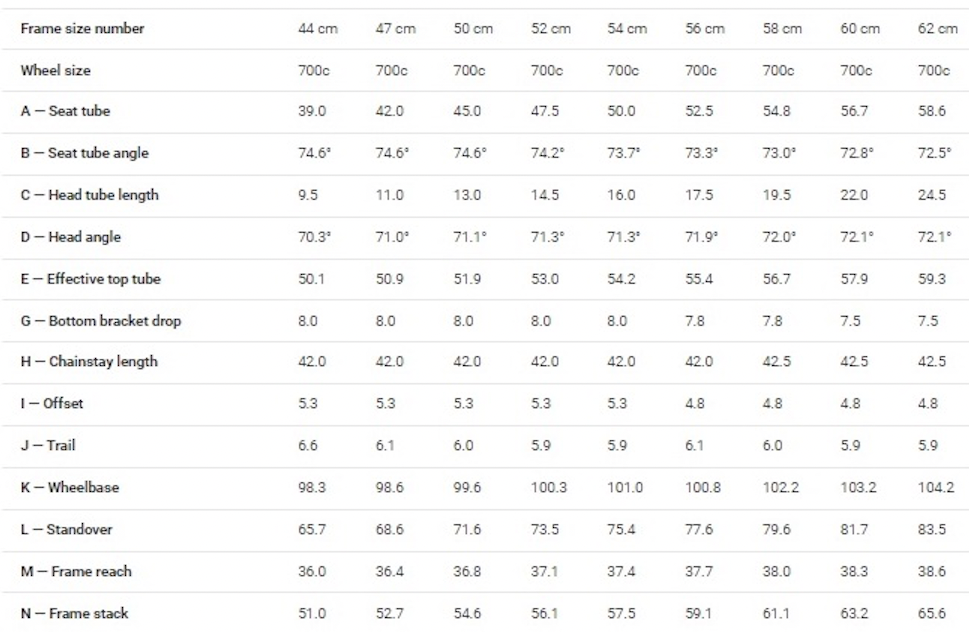
The RSL version previously mentioned features a lower and longer fit race fit that is even more aggressive than the Madone and Emonda race bikes with the brand’s H1.5 geometry. The RSL is only offered in five sizes, from 52 to 60cm.
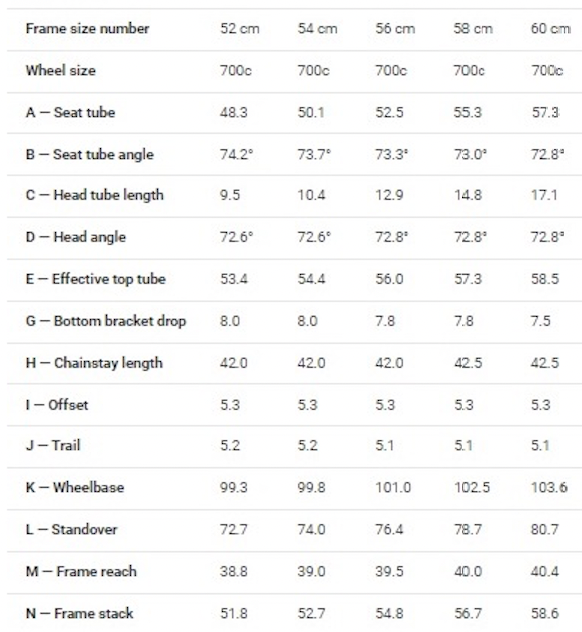
Trek Domane Mk.IV—Builds, Prices, and Weights
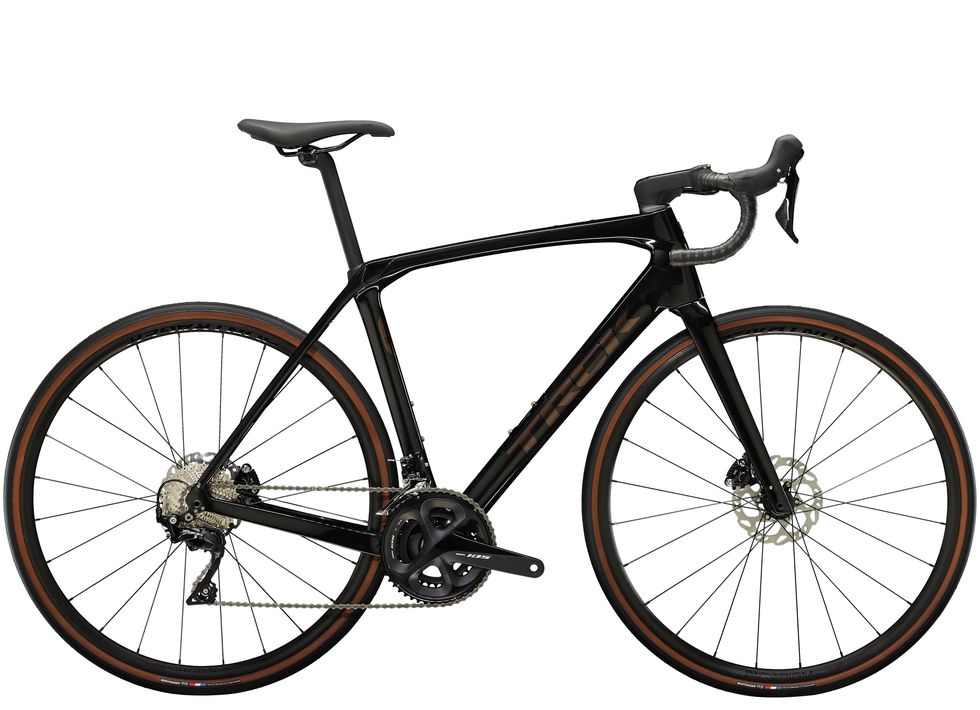
Trek’s rolling out the new Domane with 11 models: five SL builds priced between $3,500 to $7,500 and six SLR models priced at $8,000 to $13,200. Only one model, the $3,500 SL 5, has a mechanical shifting drivetrain (Shimano 105); all the rest have electronic drivetrains from Shimano and SRAM. The SL 5 is also the only 11-speed bike; the rest are 12-speed.
All models come with Bontrager tubeless-ready wheels and Bontrager’s R3 folding-bead, tubeless-ready tires in 32mm.
Claimed weights start at 8.93Kg (19.7 lb.) for the SL 5, with the lightest complete bike coming in at 7.25kg (16 lb.). One interesting note on prices and weights: For the same relative equipment level— Ultegra Di2 versus Force eTap AXS —most Shimano-equipped bikes are less expensive and lighter than the SRAM-equipped bikes. There is a big “but” because all SRAM-equipped Domanes from the SL 7 eTap and up have power meters while the Shimano builds have standard cranks. The other exception is the SL 6 ( Shimano 105 Di2 ) and SL 6 eTap ( SRAM Rival eTap AXS )—the Shimano bike is $600 cheaper but slightly (10 grams) heavier.
As always, the Domane will eventually, though not immediately, find its way into Trek’s Project One customization program for riders who want to pick their parts and paint. Trek also offers the SL ($2,499), SLR, and RSL (both $4,200) framesets for purchase.
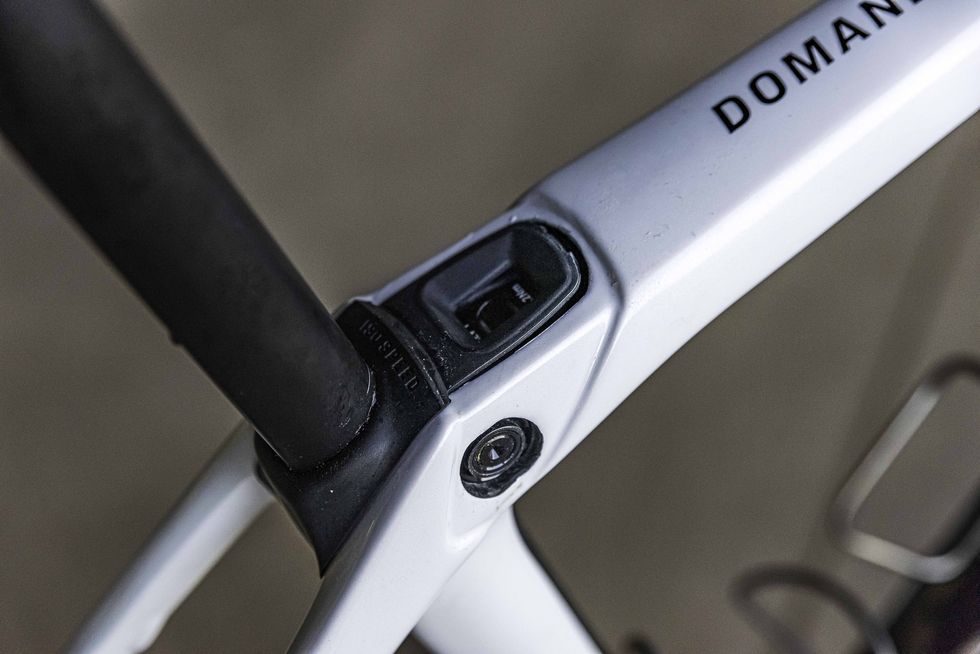
Trek Domane Mk.IV—Ride Review
Trek’s Domane has been a favorite of mine since the first generation, but the third generation was flat-out amazing. Comfortable, practical, and fun, it had most of the speed of a race bike without the bullshit that makes race bikes so limited and limiting. It fits big tires! You could run any bar and stem! It could store a burrito in the downtube! And it was fast .
So when Trek told me they were sending me the new, fourth generation, Domane I hoped and prayed that they found a way to make it better without messing up what made it so great. And friends, my hopes and prayers were answered because riding the fourth generation Domane was like reacquainting with a dear old friend, but one who lost a bunch of weight and now goes to therapy. Because this bike is everything the gen-three Domane was, but better.
You can read what I said about the third-generation Domane when I reviewed it and when I wrote it up as our 2020 Bike of the Year and take all of the good stuff and apply it to the new, fourth-generation Domane. But my complaints about it being a little heavy are gone. And with the weight reduction, the gen-four Domane unlocks new performance levels.
The biggest difference is the new bike is quicker, snappier, and just flies. When you hear someone talk about a comfortable road bike, it usually suggests a bike that is squishy and slow feeling. But when you get on a bike that is fast, quick, and communicative but also floats and coddles the rider like a newborn baby, well, that is a special bike. And that is what the new Domane is: Special. A great bike made better. A bike for the modern road rider: Freaking fast, wonderfully comfortable, and oh so practical.

A gear editor for his entire career, Matt’s journey to becoming a leading cycling tech journalist started in 1995, and he’s been at it ever since; likely riding more cycling equipment than anyone on the planet along the way. Previous to his time with Bicycling , Matt worked in bike shops as a service manager, mechanic, and sales person. Based in Durango, Colorado, he enjoys riding and testing any and all kinds of bikes, so you’re just as likely to see him on a road bike dressed in Lycra at a Tuesday night worlds ride as you are to find him dressed in a full face helmet and pads riding a bike park on an enduro bike. He doesn’t race often, but he’s game for anything; having entered road races, criteriums, trials competitions, dual slalom, downhill races, enduros, stage races, short track, time trials, and gran fondos. Next up on his to-do list: a multi day bikepacking trip, and an e-bike race.

.css-7piy6r:before{width:1.75rem;height:1.75rem;margin:0 0.625rem -0.125rem 0;content:'';display:inline-block;-webkit-background-size:1.25rem;background-size:1.25rem;background-color:#F8D811;color:#000;background-repeat:no-repeat;-webkit-background-position:center;background-position:center;}.loaded .css-7piy6r:before{background-image:url(/_assets/design-tokens/latest/bicycling/static/images/chevron-design-element.c42d609.svg);} Member Exclusive

3 Workouts to Help You Get Faster

How This Mountain Biker Keeps Riding

Evening Exercise and Your Sleep

How to Fit Cadence Training Into Your Schedule

Does Eating Sugar Make You Age Faster?
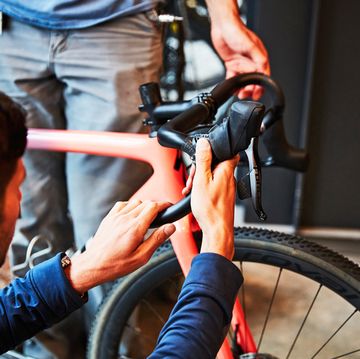
Quick Tips for Making Your Bike More Comfortable

Firefly’s Custom Gravel Bike is Cycling Artwork

The Benefits of Hamstring Curls for Cyclists

The Best Wireless Dropper is the Fox Transfer Neo

How to Become a Better Climber

The Best Bike Is an Old Track Bike


- ALL (67 Forums)
- WHEELS & TIRES
- SPECIALIZED
- CYCLOCROSS BIKES
- TIRES & WHEELS
Trek Domane 5 Series Road Bike

Domane 5 Series is your cobble-tuned secret weapon in a ride-all-day race. IsoSpeed technology and Domane geometry give this carbon endurance race bike the winning edge.
- USER REVIEWS
Comfort, Lightness, Handling, & Speed
I had the Trek Madone 5 Series for a year and a half and loved it. I put plenty of miles on it, but rode like new. I stopped in at Atlanta Cycling for some gloves and saw the Domane 5 Series which looked good. The manager asked if I would like to try it out and I did. To make a long story short, after riding the Domane,I traded-in my Madone for the Domane. The Domae is a much more responsive bike with regards to acceleration and cornering and the comfort is FANTASTIC. I can't imaging any other bike providing such a terrific ride for the price as the Domane Series 5.
I'm coming off a Silk Road Cannondale (S1000) CAD3. This is big step in weight difference. Incredibly smooth and absorbs Arkansas road deficiencies extremely well. The ISO damper really helps the cushion the road vibration and bumps from being transmitted to the butt and back.
Front end vibrations are more, but drowned out appreciatively. Hard to beat out a headshok. However, the carbon fork more than makes up for it in responsiveness on the hills. You have to be smooth on power and cadence or you notice the seat movement, just something you have to get used to.
$2760 (2013 new) bought Jun 2014. Both bikes had Shimano Ultra (no sig diff). Smooth and absorbing in the seat with out of the seat response and stiffness. Extremely satisfied.
comfort, quality construction, styling/design
I moved to this bike from a steel Ritchey road bike and this bike blows the Ritchey away. The Domane is more comfortable, handles better and stiffer/faster then the Ritchey. I live in northern new england and the roads are really bad. We also have a lot of dirt roads so I feel like this is a great bike for this area. When I do hit a smooth section of pavement the Domane makes it feel like a silk road.
Smoothest most comfortable and stable bike I have ever ridden. Frame is very stiff but due to the isozone decoupler which allows the seat post to flex when riding over rough roads it really irons out the bumps.
Maybe a little slower than the Madone but there isn't much difference. Gladly sacrifice a little speed for comfort, as I used to own a Madone and for me this is a better bike.
Highly recommended. When I am ready to upgrade I'll go for the 6 series Domane.
Get the latest road bike reviews, news, race results, and much more by signing up for the Roadbikereview Newsletter
Hot Deals See All Hot Deals >>
Get the latest roadbike reviews, news, race results, and much more by signing up for the Roadbikereview Newsletter
- EDITORIAL REVIEWS
- CLASSIFIEDS
ABOUT ROADBIKEREVIEW
- TERMS OF USE
- PRIVACY POLICY
- ADVERTISING
VISIT US AT
© Copyright 2024 VerticalScope Inc. All rights reserved.

2023 Trek Domane SL 5 Gen 4 Review
Trek has been one of the leading manufacturers in the cycling industry for decades, and their latest release is no exception.
The 2023 Trek Domane SL 5 Gen 4 is a high-end road bike that promises to deliver a smooth and comfortable ride while also being fast and efficient.
In this review, we will take a closer look at the features of the 2023 Trek Domane SL 5 Gen 4 and evaluate its performance on the road.

Whether you’re a seasoned cyclist or a beginner, this bike may be the perfect addition to your collection. So, let’s dive into the details and see what this bike has to offer.
The Trek Domane SL 5 Gen 4 is a road bike that has been designed for endurance rides and long-distance cycling.
With a lightweight carbon frame and a comfortable riding position, this bike is perfect for riders who want to take on challenging rides without sacrificing comfort.

The 2023 Trek Domane SL 5 Gen 4 is a top-of-the-line road bike that offers exceptional performance and unmatched comfort.
Designed for serious cyclists who demand the best, this bike is packed with advanced features that make it the perfect choice for long-distance rides, races, and everything in between.

– Advanced 500 Series OCLV Carbon frame construction for maximum strength and durability.
– IsoSpeed decoupler technology absorbs bumps and vibrations for a smooth, comfortable ride.
– Shimano 105 2×11 groupset featuring a 11-34t cassette and compact 50/34t chainrings provide reliable shifting and excellent performance.
– Tubeless-ready Bontrager Paradigm SL wheels and Bontrager R3 Hard-Case Lite 700x32mm tires for improved traction and reduced rolling resistance.
– Flat mount Shimano 105 hydraulic disc brakes for superior stopping power and control.
– Bontrager carbon seatpost and alloy handlebars for a lightweight, responsive feel.
– Sleek, modern design with eye-catching color options.
– Excellent customer reviews and ratings.

Frame and Design
The 2023 Trek Domane SL 5 Gen 4 comes with a lightweight 500 Series OCLV Carbon frame that has been designed to provide maximum comfort on long rides.
The frame features Trek’s IsoSpeed technology that helps to absorb road vibrations, making the ride smoother and more comfortable.
The bike also comes with a carbon fork that helps to reduce weight and increase stiffness.

The 2023 Trek Domane SL 5 Gen 4 comes with a Shimano 105 2×11 groupset, which is known for its reliability and smooth shifting.
The bike features a compact 50/34T crankset and an 11-34T cassette that provides a wide range of gears for climbing hills and sprinting on flats.
The bike also comes with Bontrager Paradigm SL wheels that are lightweight and provide excellent aerodynamics.

The 2023 Trek Domane SL 5 Gen 4 has been designed for maximum comfort on long rides.
The bike features Trek’s IsoZone handlebar system that helps to reduce road vibrations and provide a comfortable grip.
The bike also comes with a Bontrager Verse Short Comp saddle that provides excellent support and comfort for the rider.

Performance
The 2023 Trek Domane SL 5 Gen 4 is a bike that is designed for endurance rides and long-distance cycling.
The bike’s lightweight frame and comfortable riding position make it easy to ride for long hours without feeling fatigued.
The bike’s Shimano 105 groupset provides smooth shifting and a wide range of gears, making it easy to tackle challenging climbs and sprint on flats.
The 2023 Trek Domane SL 5 Gen 4 is a road bike that has been designed for endurance rides and long-distance cycling.
With its lightweight frame, comfortable riding position, and reliable components, this bike is perfect for riders who want to take on challenging rides without sacrificing comfort.
If you’re looking for a bike that can take you on long rides and provide maximum comfort, the 2023 Trek Domane SL 5 Gen 4 is definitely worth considering.
Order online and have it shipped to your local dealer for final assembly!!
View these other popular posts
- Giant TCX Advanced Pro 1 Review
- Trek E-Caliber 9.9 XX1 AXS Gen 2 Review
- Salsa Horsethief SLX Review
- 2023 Cannondale Quick 2 Review
- Giant FastRoad AR 2 Review
Related Posts

Nukeproof Megawatt 297 RS Review

Trek E-Caliber 9.9 XX1 AXS Gen 1 Review

Salsa Journeyman Claris

REI Co-op Cycles DRT 3.3 Review
Trek Domane 5.9 Dura-Ace review
The essence of what an endurance bike should be.
You can trust Cyclingnews Our experts spend countless hours testing cycling tech and will always share honest, unbiased advice to help you choose. Find out more about how we test.

This article originally appeared on BikeRadar
First look: Fabian Cancellara's 2014 Trek Domane 6-Series
Trek Domane Disc 4.0 and 6.9 announced
Trek Domane Koppenberg frameset released
Pro bike: Dan McConnell's Trek Domane Koppenberg
Pro bikes: Devolder's Domane Classics and Domane Koppenberg
Every occasion we get to ride Trek's Domane we're astonished anew by its capabilities. From the outset it’s like climbing aboard a suspension bike – or at least a cyclocross machine with large, low-pressure tyres. But that description doesn't do justice to the urgency that’s matched to its unerring comfort – on the tarmac it just conquers any and every surface texture, from billiard table-smooth to broken and potholed.
It should have no right to be this good, but ride one and you'll see why Fabian Cancellara prefers the Domane as his year-round race bike, not just for the cobbled Classics. The key is the Isospeed Decoupler, which allows the essentially floating seat tube to pivot and flex freely at the top-tube/seatstay junction, and the similarly effective Isospeed fork.
For dyed-in-the-wool roadies brought up to believe that stiff and rigid means more speed, and cushioning is for wimps, the result is mind-altering. Not only is the majority of unwanted road vibration killed off well before it reaches you, but power transfer and handling finesse are completely unaffected. You get a blisteringly rapid race bike with more comfort, more grip and more confidence. It's the true definition of endurance – a bike that looks after your muscles and contact points, so you remain fresher for longer, and can therefore ride further, faster.
It really is a win-win situation. On short climbs, the Domane can punch with the best, and there's no compromise on sustained gradients, but on the exposed, corrugated and heavily potholed gravel roads that comprise the high point of our test route, where winter had replaced dust with slimy mud – conditions only a ’cross bike should love – the Domane was never less than planted.
The ride quality with slick 25mm tyres inflated to 90psi felt more like 32mm tyres at 40psi. Control was never in question, slippy off-camber line changes and pothole weaving were simple, and rejoining rain-lashed tarmac we felt a level of trust in the Domane's performance that enabled us to commit to technical corners with confidence.

The Domane's ride quality is awesome even on rugged surfaces – but there's no lack of killer instinct
Our frame may have lesser carbon than the one Fabian rides, but mechanical Dura-Ace is the big man's choice for foolproof operation on the cobbles, and it would be our preference. Silky smooth, devastatingly efficient and ergonomic, it has pro written all over it. The Bontrager RL wheelset is a cost saver, but acquits itself very well, proving the value of matching wheels to a frame. They're 24mm wide, shallow and asymmetric, with 25mm rubber that measures 26mm, adding extra stability to an already composed ride. With the asymmetric frame, the wheels give willing, if not electric, acceleration, but always feel positive and exceptionally nimble whether driving into a headwind or stomping up a local berg.
The clever Ride Tuned seatpost slides externally over the frame's extended seat-tube. It's simple to adjust, adds rigidity and seals the frame against water and filth ingress – just as well, given the conditions we tested in. Bontrage's Paradigm saddle is a fine shape and extremely comfortable, and there are even Trek's hidden mudguard mounts for those days you're not racing to Roubaix.
There are no concessions to aerodynamics, just a superlative race bike that thinks it's a fat bike. It climbs with the best, descends better than most, and will go places no other road bike should. It's as much of an all-rounder as the man who took his third Flanders crown last spring.
Specification Name: Domane 5.9 Dura Ace (15) Built by: Trek Price: £3300 / US$5150 / $5299
Features Cassette: Shimano Ultegra 11-28 Chain: Shimano Ultegra Cranks: Shimano Dura-Ace, 50/34 Fork: Isospeed carbon Frame Material: Trek OCLV 5 Series carbon Front Derailleur: Shimano Dura-Ace, braze-on Front Tyre: 25mm Bontrager R3 Handlebar: Bontrager RL Isozone alloy Rear Derailleur: Shimano Dura-Ace Rear Tyre: 25mm Bontrager R3 Saddle: Bontrager Paradigm RL Seatpost: Bontrager Ride Tuned carbon seatmast Shifters: Shimano Dura-Ace, 11 speed Stem: Bontrager RXL alloy Weight (kg): 7.08 Wheelset: Bontrager RL Year: 2015 Weight (lb): 15.61 Frame size tested: 56cm

Thank you for reading 5 articles in the past 30 days*
Join now for unlimited access
Enjoy your first month for just £1 / $1 / €1
*Read any 5 articles for free in each 30-day period, this automatically resets
After your trial you will be billed £4.99 $7.99 €5.99 per month, cancel anytime. Or sign up for one year for just £49 $79 €59
Try your first month for just £1 / $1 / €1
After a year of waxing my chains here’s why I’m going back to oil
Campaign across the UK cycling industry aims to increase e-bike battery safety
Enric Mas avoids major downhill crash during morale-boosting Vuelta a España attack
Most Popular
220 Triathlon
When you purchase through links on our site, we may earn an affiliate commission.
Home / Reviews / Trek Domane 5.9 review
Trek Domane 5.9 road bike review
Trek Domane 5.9 tested and rated by our expert reviewer
The Domane is Trek’s endurance race bike, which might sound like a contradiction in terms until you realise that it’s the bike three-time Paris–Roubaix winner Fabian Cancellara rides. Basically, it’s a bike designed for being ridden hard over rough terrain, and it doesn’t get any rougher than the cobbles of northern France.
Unlike Cancellara’s bike, which is constructed with geometry far more like a traditional racing steed, the production version of the Domane has all the hallmarks of an endurance bike – a tall head tube, longer chainstays, a steeply sloping top tube – plus one unique touch: the IsoSpeed decoupler. This is found at the seat tube/top tube junction and isolates the seat tube from the rest of the frame, increasing compliance so that the road feels smoother.

The decoupler contains a bearing system that allows for a few degrees of movement and, as such, increases the comfort of the ride. And it works – the Domane is a remarkably smooth-travelling bike. Thrashing around our usual test roads, it was notably more comfortable than almost any of the bikes we regularly test there, and we still felt fresh after several hours of riding.
Top comfort
Of course, the ride position is also key and the shorter top tube, longer head tube and resulting more upright position combine to save your back and neck from aching after a long ride. Which isn’t to say that the Domane can’t be raced. Not at all. Move down to the drops and push the pedals hard and you’ll elicit as pleasing a reaction from this as anything you’re likely to find on the market.

The Dura-Ace levers provide a really light stroke when you’re shifting which is rewarded by a reassuring clunk at the cassette
Trek and Cannondale (with the Synapse) are the leaders in endurance road bikes designed to be ridden in anger, and if you want to let fly on the Domane, it’ll more than oblige. The one caveat is that you wouldn’t want to stick tri bars on this, because the taller head tube would reduce the aero benefit.
Added to the mix is excellent handling. With other endurance-focused road bikes, we’ve found descending to be somewhat uncertain, feeling like you’re high up and precariously perched. Not so with the Domane. It’s grounded solidly to the road and handles precisely without ever feeling twitchy, giving you the confidence to really push it through corners and downhill.
The groupset is Shimano’s Dura-Ace 9000 drivetrain in its entirety and it’s worth saying once more just how good it is. Shifting is crisp, the power in the front is astonishing, and moving up/down is rewarded with a light lever stroke but a reassuring clunk when the chain moves into place.
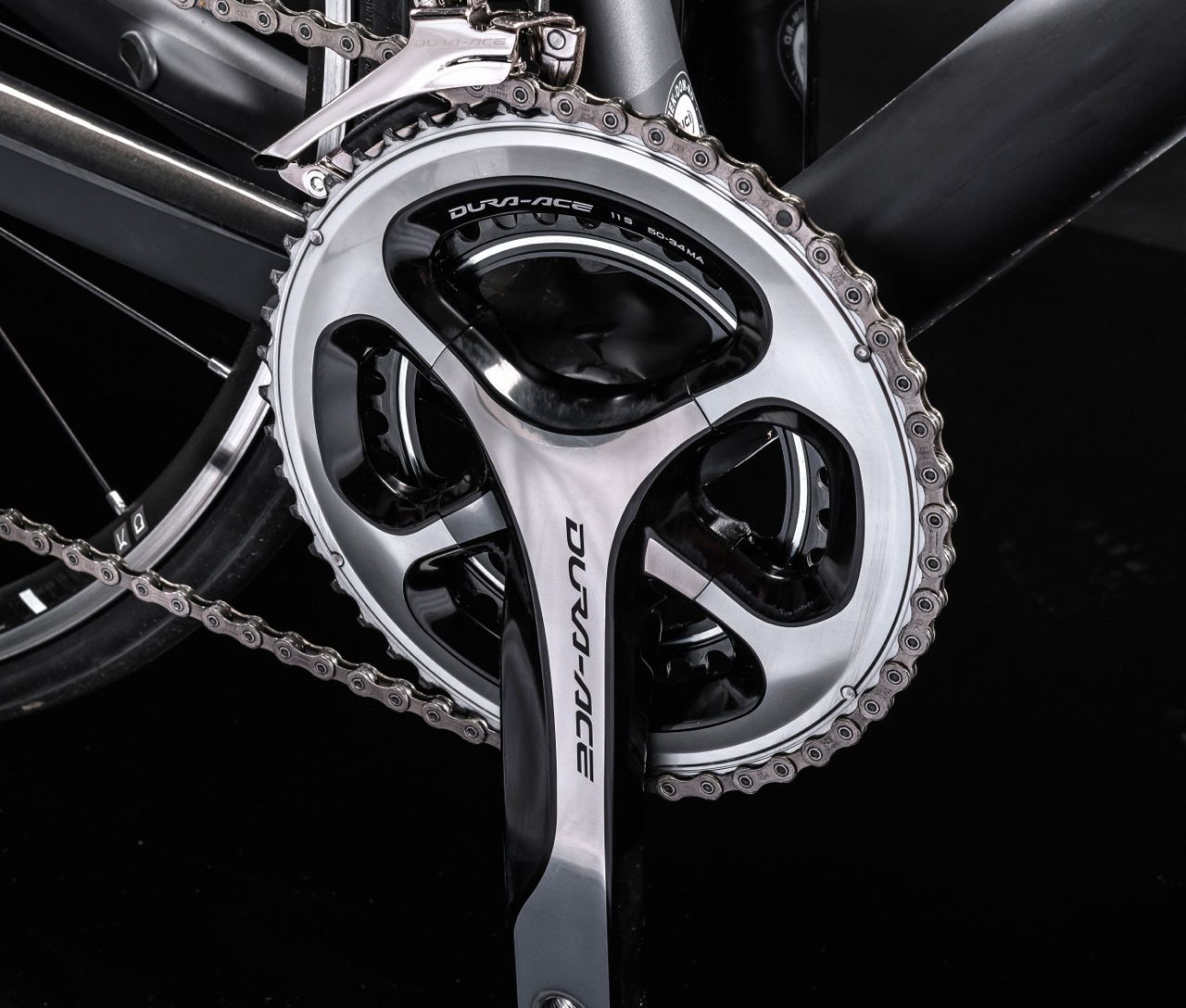
The Shimano Dura-Ace 9000 crankset might be polarising with its looks, but gets the job done extremely well
The brakes are of a similarly high calibre and combine superb stopping power with excellent sensitivity. Underneath, the Bontrager RXL wheels are a very capable set of aluminium clinchers that are tubeless-ready, which is a nice little extra. They won’t zip you along like a full-on set of race wheels, but they’re light, responsive and a cut above the standard wheels you often find specced on bikes like this.
Three-and-a-bit grand might be a big spend, but you’ll be adding a whole lot of class to your garage for the price. Or, for just £1,000, there’s the Domane 2.0, which shares a lot of the 5.9’s top-notch genealogy.
Verdict: A stunning bike. Amazing comfort coupled with a penchant for speed. If you want to get out and ride no matter what the terrain or conditions, this is the one – 90%
Contact : www.trekbikes.com

Mike Anderson was 220 Triathlon's staff writer between 2011 and 2014.
Related content
Jonas deichmann completes 106 consecutive long-distance triathlons and breaks world record.
Jonas Deichmann has announced that he has broken a key triathlon world record. The German adventurer has completed the highest number of long-distance triathlons on consecutive days

The best running watches for women in 2024
Track your run and refine your performance with our picks for the best running watches for women on the market right now

Best cold water swimming hats and thermal swim caps in 2024
Want to keep open-water swimming during the winter, but struggling with putting your head under? Here are some of the best cold water swimming hats on the market…

- Every issue delivered direct to your door
- Get six issues for £19.97(saving 64% on the normal price)
- Thereafter continue to save 60% every 12 months
- Guarantee you will never miss an issue
- FREE 220 Triathlon e-newsletter
No thanks, I’m not interested!

Is Trek Domane SL 5 Gen 4 A Perfect Selection? – [Trek Domane SL 5 Gen 4 Review]
Table of Contents
Trek Domane SL 5 Gen 4 Review
- Price: $3,499
- Frame: Carbon
- Tires: 700c Aluminum
- Gears: 2 × 11
What we like about it: It can effortlessly handle rough roads and long journeys, providing a smooth and aerodynamic ride.
What we don’t like about it: The limited adjustability range of the seat post.
Rating: (4.9/5)
.jpg)
The Trek Domane SL 5 Gen 4 features a lightweight 500 Series OCLV carbon fiber frame and rear IsoSpeed, which absorbs road vibrations and ensures a comfortable ride. Its integrated bike seat enhances both its appearance and riding feel.
Now, let’s dive into the riding experience, key features, components, specifications, and other versions of the Trek Domane SL 5 Gen 4. In the latter part of this article, we will also compare it with several other top bicycle models. If you’re interested in more bike reviews, stay tuned.
Riding Experience
.jpg)
The Trek Domane SL 5 Gen 4 offers a lightweight and responsive riding experience, with high-performance components and generous 38c tire clearance. This allows me to tackle almost any road, from smooth asphalt to gravel paths.
For this review, I took the Trek Domane SL 5 Gen 4 on a spontaneous ride through the countryside, starting with mostly flat and open roads. As I progressed, I encountered some unpaved gravel roads, providing an opportunity to test the bike’s capabilities.
Trek Domane SL 5 Gen 4 On the Road
As soon as I hopped on the Trek Domane SL 5 Gen 4, I was impressed by its responsive pedaling feedback. The lightweight and robust 500 Series OCLV carbon fiber frame contributed to the bike’s agility and speed. The integrated design of the entire bike frame made it even more aerodynamic, allowing me to pick up speed.
When I desired a faster pace, the Shimano 105 2×11 drivetrain provided silky-smooth shifting and efficient power transfer. By increasing my pedaling cadence, I effortlessly achieved higher speeds. The bike’s excellent geometry also made it easier to maintain a forward-leaning riding posture while climbing, maximizing power output. Combined with the ample gear options, I adjusted the rear derailleur to a larger freewheel, making pedaling feel light and energy-efficient when tackling uphill sections.
After conquering the climbs, and facing a long downhill stretch, I took advantage of inertia and barely needed to pedal to maintain high speeds. The Shimano 105 hydraulic disc brakes, on the other hand, offered strong and reliable stopping power. A gentle squeeze was all it took to apply ample braking force, ensuring safety and stability during downhill rides.
Gravel Riding
The Trek Domane SL 5 Gen 4 also proved to be a capable gravel bike. Towards the end of my ride, I encountered a stretch of gravel road.
Thanks to the carbon fiber frame, front fork, and rear IsoSpeed design, the bike absorbed road vibrations, providing a smoother and more comfortable ride.
The 700c wheels demonstrated excellent rolling capability, allowing me to effortlessly navigate over minor gravel obstacles. The 700x32c tires, in my opinion, were sufficient for handling these gravel sections. However, if you still have concerns, the Trek Domane SL 5 Gen 4 supports a 38c tire clearance, which should alleviate any worries.
Specifications
.jpg)
The Trek Domane SL 5 Gen 4 offers a smooth, aerodynamic, and comfortable ride. Its lightweight 500 Series OCLV carbon fiber frame, combined with the rear IsoSpeed design, eliminates road vibrations and reduces rider fatigue.
The bike is available in 7 frame sizes, catering to riders with heights ranging from 4’11” to 6’2″. It covers a wide range of rider heights, making it suitable for a diverse audience.
It features the reliable Shimano 105 drivetrain, known for its smooth shifting. Additionally, the Shimano 105 hydraulic disc brakes provide all-weather stopping power, remaining dependable even in adverse conditions.
Finally, the down tube houses a convenient internal storage space for essential riding items, making it suitable for long-distance rides. Additionally, the generous 38c tire clearance allows you to ride on nearly any road surface, from asphalt to gravel.
What do we like about it?
- IsoSpeed technology and up to 38mm tire clearance absorb road fatigue and provide a smoother, more comfortable riding experience.
- Wireless 2×11 Shimano 105 drivetrain, offering excellent reliability for entry-level professional components.
- It is versatile and smooth, suitable for long rides on open roads, gravel riding, and racing.
- The internal storage compartment in the down tube offers a multifunctional space for riders to store tools and cycling gear.
- The new frame design reduces weight and offers higher riding speeds with an updated Kammtail tube shape.
- The stable endurance geometry ensures comfort on long rides while maintaining the speed of a racing bike.
What don’t we like about it?
- The limited adjustability range of the seat post.
- What is the rider weight limit for this bike?
The rider weight limit is 275 pounds, which is the standard limit for other Trek road bikes.
- Can this bike accommodate gravel tires?
It can accommodate 38mm gravel tires.
- How do I choose the right size?
These sizes are general guidelines, and the best way to find your perfect size may vary from person to person. The easiest way to determine your size is to go for a test ride.
Trek Domane SL 5 Gen 4 Specs
C omparison t able, trek domane sl 5 gen 4 vs. trek domane sl 6 gen 3.
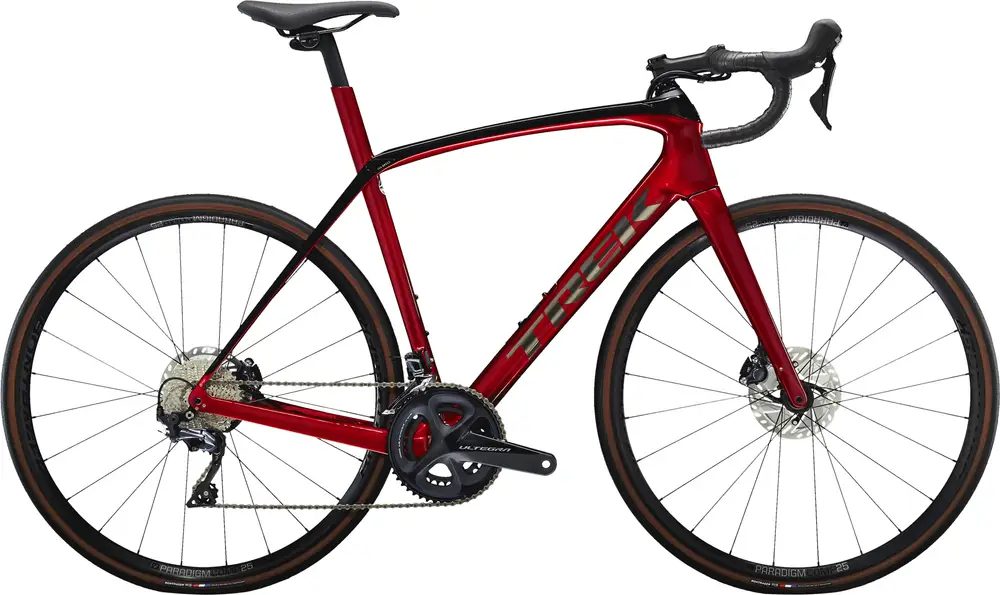
Comparing these two bikes, the latter features a higher-level Shimano Ultegra R8000 drivetrain compared to the former, which comes equipped with Shimano 105 components. Therefore, the shifting and transmission efficiency will be slightly better on the latter.
Regarding braking performance, both of these bicycles offer reliable and trustworthy braking capabilities. However, the latter has a higher-level component, which primarily translates to improved operation.
So, between these two bikes, the Trek Domane SL 6 Gen 3 appears more like an upgraded version of the Trek Domane SL 5 Gen 4, and you can choose based on your budget.
Learn More: Is Trek Domane SL 5 Worth Buying? [Trek Domane SL 5 Review]
Trek Domane SL 5 Gen 4 vs. Liv Avail Advanced 2
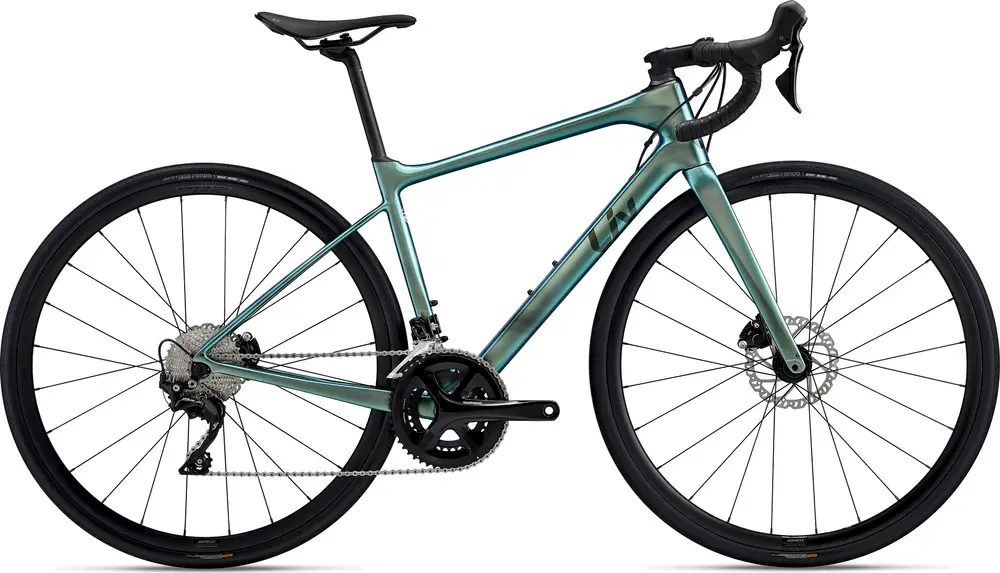
In terms of geometry, the former has a more aggressive design, suitable for higher riding speeds. Meanwhile, the latter features a geometry more akin to a mountain bike, giving it better off-road riding capabilities.
As for the drivetrain, both bikes use Shimano 105 components, ensuring smooth gear shifting and excellent transmission efficiency. In the braking department, both provide reliable and powerful braking, offering riders peace of mind. However, the latter has components of a slightly higher level, which translates to better operation.
Ultimately, between these two bikes, you can choose based on your preference for the type of riding terrain you favor.
Learn More: Is Liv Avail Advanced 2 Worth Buying? – [Liv Avail Advanced 2 Review]
Trek Domane SL 5 Gen 4 vs. BMC Roadmachine FIVE

In terms of frame design, the former offers more detailed features. For instance, the IsoSpeed technology and the storage space on the downtube enhance the overall riding experience.
However, when it comes to drivetrain components, both bikes use Shimano 105 drivetrain components. The latter, however, features an electronic version with more gear options and easier daily adjustments. On the other hand, the mechanical version of the former is lighter in weight.
Finally, the former has slightly wider tire sizes, making it suitable for riding on more varied road surfaces and providing a more comfortable riding experience. The latter has lower rolling resistance, resulting in higher riding speeds.
So, between these two bikes, if you’re looking for a faster riding experience, the BMC Roadmachine FIVE is the better choice. Conversely, the Trek Domane SL 5 Gen 4 offers better overall riding capabilities.
Learn More: Is BMC Roadmachine X Two Worth Buying? [BMC Roadmachine X Two Review]
Trek Domane SL 5 Gen 4 vs. 2022 Bianchi Impulso – GRX 810
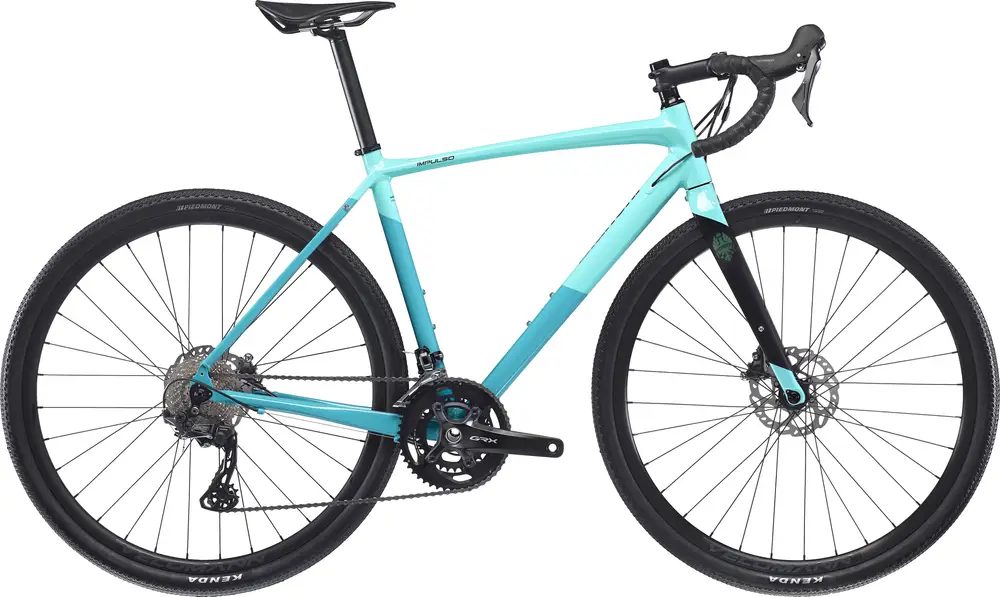
When comparing these two bikes, the latter is undoubtedly more of a pure gravel bike.
In terms of the drivetrain, the former uses Shimano 105 road bike components, offering better drivetrain efficiency. However, the latter is equipped with Shimano GRX 800 gravel bike-specific components, making it more robust and durable.
Furthermore, regarding the geometry, the former has a more aggressive riding posture, allowing for faster riding speeds. In contrast, the latter has a looser geometry, which makes it better suited for handling complex road surfaces.
In summary, the Bianchi Impulso – GRX 810 excels in off-road riding capabilities and is more suitable for gravel biking, while the Trek Domane SL 5 Gen 4 offers higher riding speeds.
Learn More: Is Bianchi Impulso Pro – Ekar A Great Bike? [Bianchi Impulso Pro – Ekar 1x13ps Review]
The above is my review of the Trek Domane SL 5 Gen 4. In our opinion, it is a versatile endurance bike that handles various road surfaces with ease, which is why we gave it a rating of 4.9.
Of course, if you want to learn about other endurance bikes, we also review many bikes of various price ranges, and we find them all quite interesting. We welcome you to check out our related tests.
Lastly, if you enjoy our content, please feel free to share it with your friends. If our content has been helpful to you, you can click the email subscription button below. Thank you for your support!
Related Posts
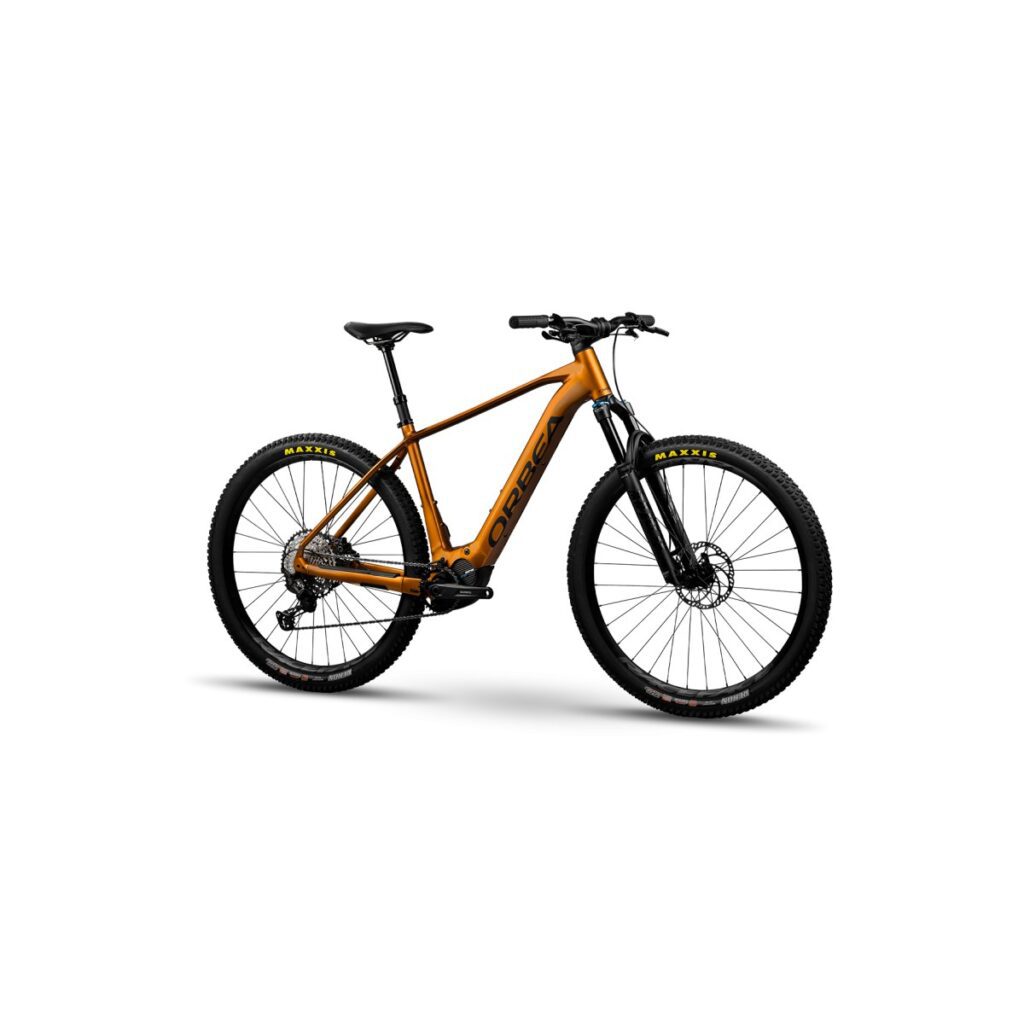
[Orbea URRUN 10 20mph Review] – Best Used By People Who Enjoy Riding To Get AFeel For The Mountains!
[schwinn admiral hybrid bicycle review] -is schwinn admiral hybrid bicycle worth buying?.

[Specialized Turbo Como 5.0 Review] – Good Choice?
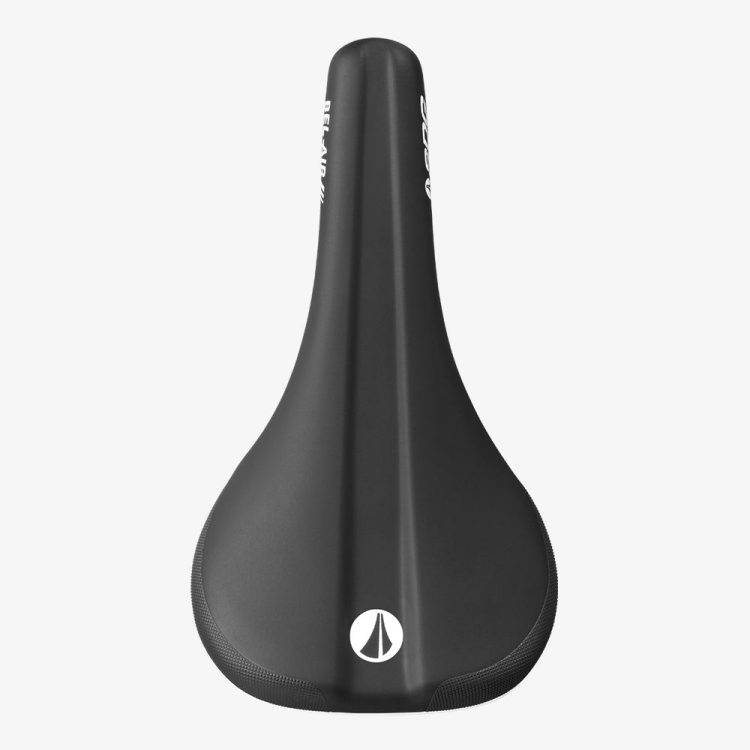
15 of The Best Mountain Bike Saddles You Can Buy
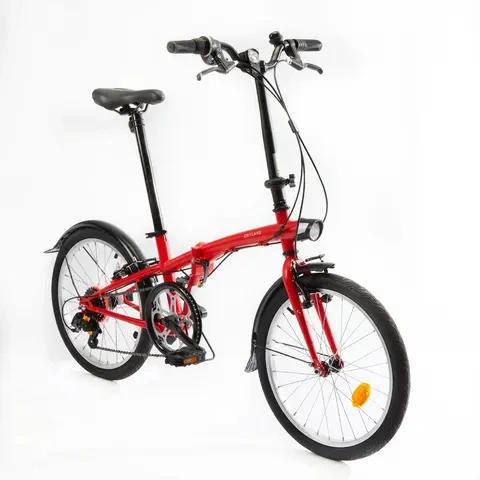
20 INCH FOLDING BIKE BTWIN 120 Review-Fold up and put in “pocket”

2023 Top 10 Best Fun Kids Bike Bells – Will This Bring Joy To Your Child’s Ride?
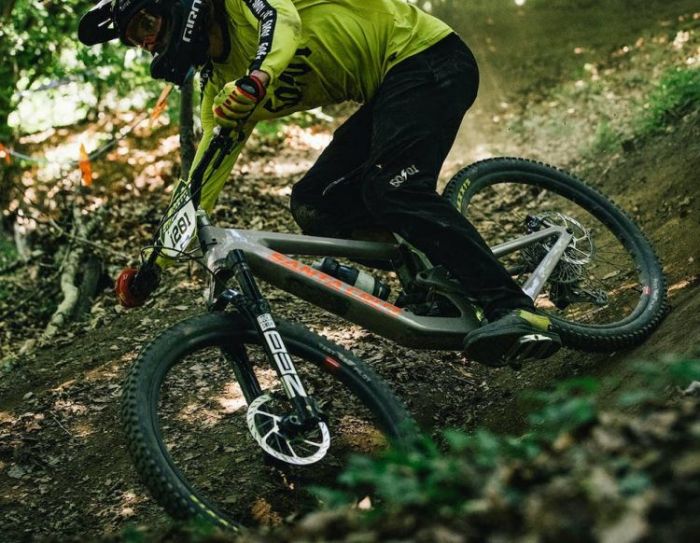

27.5 vs 29er Mountain Bikes – The Battle Of The Century

Best 20 inch Bikes For 6-13 Years Old Kids Bikes (With Gears)
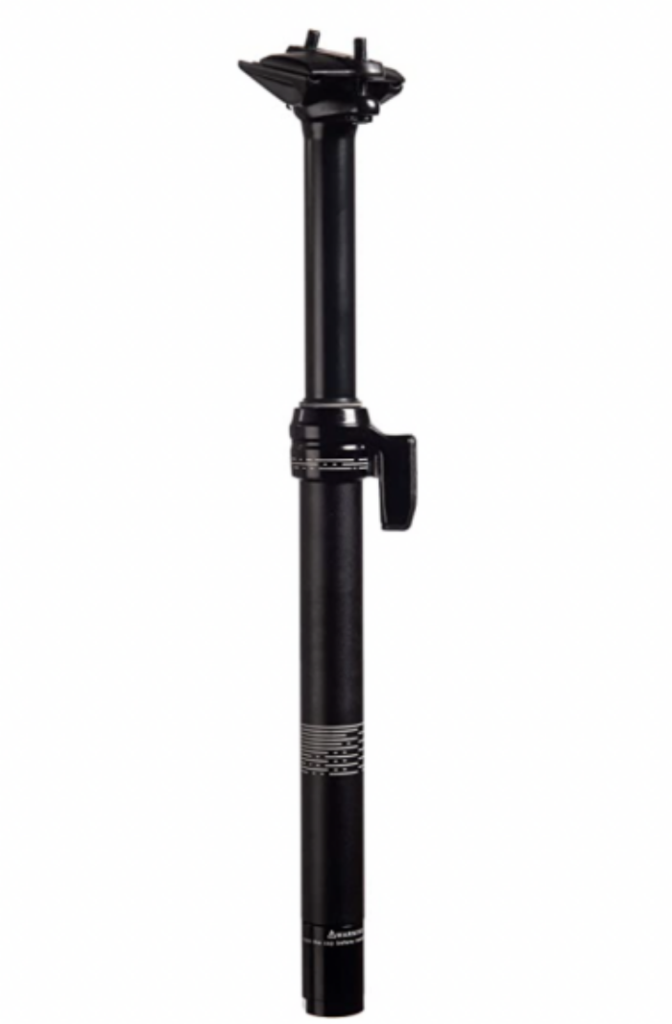
Best 27.2 Dropper Post

Best 30.9 Dropper Post In
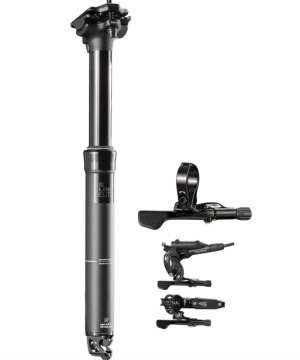
Best 31.6 Dropper Post

Best Mountain Bike Stems-Better Travel Through The Mountains And Forests
Leave a comment cancel reply.
You must be logged in to post a comment.

- Forum Listing
- Marketplace
- Advanced Search
- Manufacturer Forums
4 vs 5 vs 6 series Domane
- Add to quote
Hello, I have a very old 2001 Trek USPS 5200. I'm mostly a casual rider, but would like to upgrade. Aside from the components, and wheels. How are the 4, 5 and 6 series different from each other. I recognize that the carbon fiber is probably different, but how and how does it affect the ride of the bike? Thanks Jeff
Jeff, It's difficult to qualify the nuances between the models without actually having you get on them and ride. The reviews and feedback is too all over the place to make an educated decision from Internet forums. Not to mention, it also comes down to budget. Between the 4.0 and 6.9 you have $4800 of "options" and it's hard to convert them all to reasonable descriptions. I sell Domanes (among other bikes) on my weekends and these are traditional qualifying questions I ask: - What are your goals? - What are you riding now? - Why do you want to upgrade? My "go to" bikes are the 4.3 and the 5.2 and they're also by far the two most popular models of the Domane at our shop. Personally, I think the 5.2 is the real winner here. I like the race wheels, I like the integrated seat mast (and the added compliance from it) and the full Ultegra (brakes and cranks). Shimano really has hit it out of the park with Ultegra 6800 and it's shifting (especially FD) is quite remarkable. If the 6.2 is in the mix, I'd take the 5.9 and save the money towards some other accessories. The 6.9 is a hell of a bike, but I'd rather take the 5.9 and put some ZIPPs on them for about the same price. I encourage you to ride the 4-series and the 5-series, you might not feel enough difference on the bike to justify the 4-digit price jump. For me, if I'm going to spend that kind of money on a bike I'm going to spend enough to get me on a bike that I'm going to potentially enjoy for the next 10-15 years of my life. I'm not entirely convinced that the 4-series is that bike.
Thanks for the very thorough response. I will try and answer your questions. 1) I currently ride alone and basically follow the same route. I time myself and make it a mini TT. I just joined a local cycle club, and I will hopefully get into some more challenging group rides. I'm more of a casual rider, and do not really plan on entering any events. Although I do try and push myself. Having recently moved to Montreal, the roads here are awful so I'm looking for a more "cushy" ride. Hence the Domane over the Madone. 2) I'm currently riding a 14 year old USPS Trek 5200. 3) My bike is pretty old and to be honest the only REAL reason I'm upgrading is because I want something new. As with my current ride I plan to keep it for 10+ years so I want something that will last and I can grow into. The reason why i asked about the series difference, was to try an understand the feel of the bike. Is the lower series bike "softer"? All three bikes are in the cards price wise.
Vetsky said: The reason why i asked about the series difference, was to try an understand the feel of the bike. Is the lower series bike "softer"? All three bikes are in the cards price wise. Click to expand...
In terms of frame stiffness at the crank, I didn't feel any difference between the 4/5/6 series. The 5 and 6 are essentially identical in terms of the frame except for the cable routing, which makes a minimal difference. Largest difference I personally found after demoing them all on reasonable distance rides of 40+ mi was that the 4's seatpost results in more road buzz and road impact than the seat mast setup of the 5 and 6. I personally went with the 6 because I wanted the Race Shop version of the Domane, but if I was going with the standard Domane I'd just go with the 5 series (I was eyeing the 5.2 myself at first).
Neb said: In terms of frame stiffness at the crank, I didn't feel any difference between the 4/5/6 series. The 5 and 6 are essentially identical in terms of the frame except for the cable routing , which makes a minimal difference. Largest difference I personally found after demoing them all on reasonable distance rides of 40+ mi was that the 4's seatpost results in more road buzz and road impact than the seat mast setup of the 5 and 6. I personally went with the 6 because I wanted the Race Shop version of the Domane, but if I was going with the standard Domane I'd just go with the 5 series (I was eyeing the 5.2 myself at first). Click to expand...
The seat mast and the components are the main differences between 4 and 5 series. The 6 series real difference is color options, although the frame is lighter than the 5 series marginally. I think the 5.2 is the sweet spot in the Domane line if you like the colors. If you don't like the colors, the 2015 models should be out in a few months, might be worth waiting for.
I just purchased the Domane 5.2 after riding the 4 and 5 series and I felt the 5 series road a little smoother than the 4 series. I also agree the Ultegra 6800 is amazing. I agree the 5.2 was more than I thought I would be spending on new bike, but at 58 years this maybe the last bike a purchase and see no need to upgrade for many years to come.
Awesome. Congrats. So now it is between the 5 and 6. Is the DI2 worth the extra cash?
I have a 4.5 and love it for the most part. I did notice that it does not have a full carbon steerer? Do the 5's or 6's get a full carbon steerer (fork)? Only gripes about my bike is the cassette and the rear hub. The engagement of the hub sucks. Seems like I get half a rotation of the crank before it catches.
Thanks for the replies so far... I've long considered "rewarding" myself with an upgrade to 'celebrate' my weight-loss (c. 5-stone so far) , and the various incarnations of the Domane are high on my list. So... about me- Right now, I'm a mostly-weekends rider capable of C+ level group speed soloing. (So if I did ride in-group, I might be able to stretch myself to 'B' level in paceline.) My current bike is a 2010 Trek 1.2 I'm at the borderline between Clydesdale and former Clydesdale, and don't anticipate getting below 195 lbs, unless I receive medical advice to do so. My favorite riding activities are going distances and discovering new road-routes. I have three "centuries" under my belt, and am looking to add more. I'm interested in continuing to improve my performance, as part of an overall plan to increase general fitness. Cost is not a serious object... but I'm not inclined to spend multi-hundreds (or thousands) for slight or cosmetic differences. I am curious... and it might not even be a decisive factor [after all, I'm currently riding on Chinese Aluminum]... but how high a level of Domane does one have to acquire in order to get a US-made model?
The 6-series and 7-series Madone are made in the US. The 6-series Domane are "assembled" in the US. What specifically that means, I'm not sure. But our 6.2 Domanes clearly have a sticker that says: "Assembled in the US" on the seat mast, whereas the Madones (6 & 7) have "Made in the US." I'm under the impression that the Trek Factory Racing Domane Classics Edition is made in the US, though. We've yet to sell one at the store so I can't confirm or deny that with absolute certainty. I would encourage you to get out and ride a Domane. It's a really fantastic bike but not everyone loves them as much as people riding them. The 'endurance geometry' market gives you quite an impressive range of options now from just about every manufacturer and multiple tiers of components and features.
I can confirm that the Domane Classics Edition is NOT made in the US. I actually had to change my P1 paint choice due to that fact, the Trek rep stated the latest frames they were getting shipped in had already been clear coated, so the Carbon Smoke paint was no longer translucent as it should be (which apparently is the reason why they removed the option around the time I placed my order).
Neb said: I can confirm that the Domane Classics Edition is NOT made in the US. Click to expand...
Yes, 5s and 6's have full carbon steerer tubes. I didn't know 4.s didn't
- ?
- 206.4K members
Top Contributors this Month
- MAGAZINE OFFERS
- BIKE INSURANCE
- Best Products
- Maintenance
- Accessories
- Long-Term Reviews
- First Look Friday
- Bike of the Week
- Tech Features
- Routes and Rides
- Bike Galleries
- BikeRadar Bargains
- Buyer's Guides
- Fitness & Training
- Sizing & Fit
- Mountain Biking UK
- Cycling Plus
- BikeRadar Podcast
Trek Domane 5.9 Dura-Ace review
The essence of what an endurance bike should be
Robin Wilmott
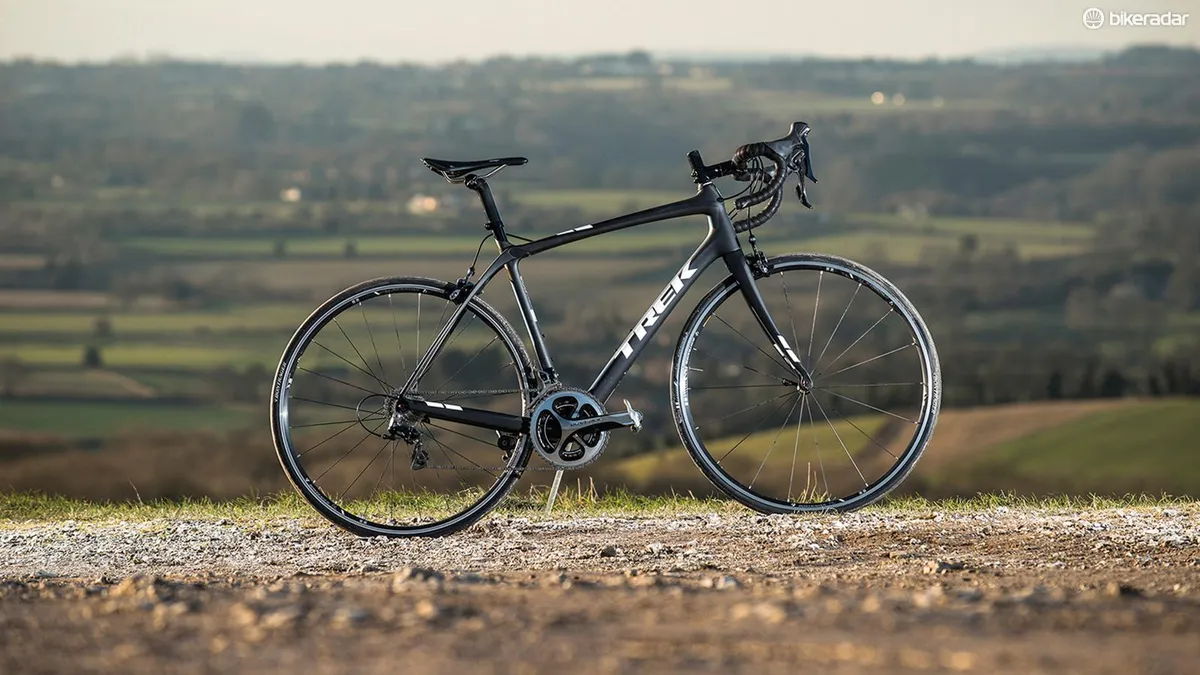
Every occasion we get to ride Trek’s Domane we're astonished anew by its capabilities. From the outset it’s like climbing aboard a suspension bike – or at least a cyclocross machine with large, low-pressure tyres. But that description doesn't do justice to the urgency that’s matched to its unerring comfort – on the tarmac it just conquers any and every surface texture, from billiard table-smooth to broken and potholed.
It should have no right to be this good, but ride one and you’ll see why Cancellara prefers the Domane as his year-round race bike, not just for the cobbled Classics . The key is the Isospeed Decoupler, which allows the essentially floating seat tube to pivot and flex freely at the top-tube/seatstay junction, and the similarly effective Isospeed fork.
For dyed-in-the-wool roadies brought up to believe that stiff and rigid means more speed, and cushioning is for wimps, the result is mind-altering. Not only is the majority of unwanted road vibration killed off well before it reaches you, but power transfer and handling finesse are completely unaffected. You get a blisteringly rapid race bike with more comfort, more grip and more confidence. It’s the true definition of endurance – a bike that looks after your muscles and contact points, so you remain fresher for longer, and can therefore ride further, faster.
It really is a win-win situation. On short climbs, the Domane can punch with the best, and there’s no compromise on sustained gradients, but on the exposed, corrugated and heavily potholed gravel roads that comprise the high point of our test route, where winter had replaced dust with slimy mud – conditions only a ’cross bike should love – the Domane was never less than planted.
The ride quality with slick 25mm tyres inflated to 90psi felt more like 32mm tyres at 40psi. Control was never in question, slippy off-camber line changes and pothole weaving were simple, and rejoining rain-lashed tarmac we felt a level of trust in the Domane’s performance that enabled us to commit to technical corners with confidence.
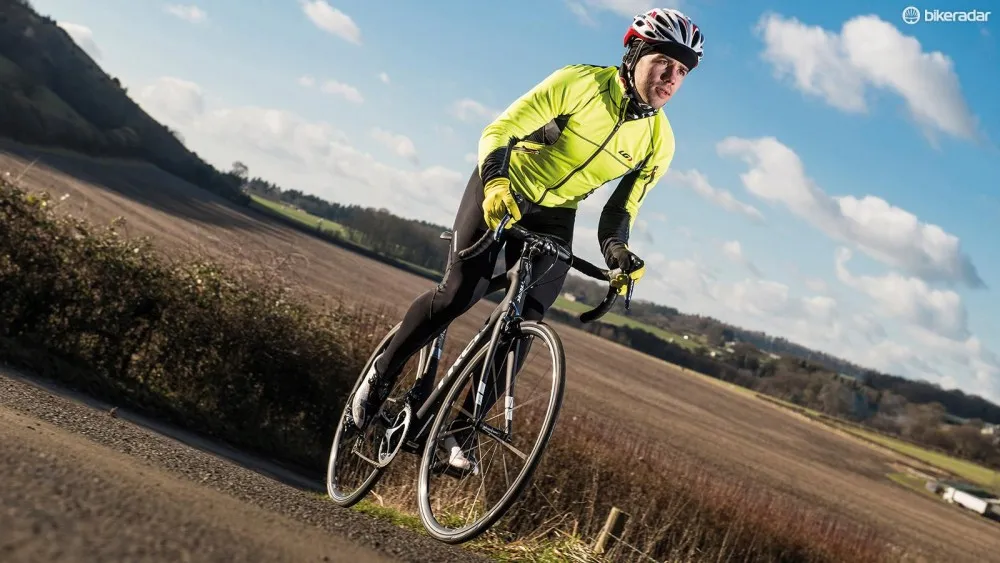
The Domane's ride quality is awesome even on rugged surfaces – but there's no lack of killer instinct
Our frame may have lesser carbon than the one Fabian rides, but mechanical Dura-Ace is the big man’s choice for foolproof operation on the cobbles, and it would be our preference. Silky smooth, devastatingly efficient and ergonomic, it has pro written all over it. The Bontrager RL wheelset is a cost saver, but acquits itself very well, proving the value of matching wheels to a frame. They’re 24mm wide, shallow and asymmetric, with 25mm rubber that measures 26mm, adding extra stability to an already composed ride. With the asymmetric frame, the wheels give willing, if not electric, acceleration, but always feel positive and exceptionally nimble whether driving into a headwind or stomping up a local berg.
The clever Ride Tuned seatpost slides externally over the frame’s extended seat-tube. It’s simple to adjust, adds rigidity and seals the frame against water and filth ingress – just as well, given the conditions we tested in. Bontrager’s Paradigm saddle is a fine shape and extremely comfortable, and there are even Trek’s hidden mudguard mounts for those days you’re not racing to Roubaix.
There are no concessions to aerodynamics, just a superlative race bike that thinks it’s a fat bike. It climbs with the best, descends better than most, and will go places no other road bike should. It’s as much of an all-rounder as the man who took his third Flanders crown last spring.
Share this article

Contributor

- Terms & Conditions
- Subscribe to our magazines
- Manage preferences

- Rider Notes
2016 Trek Domane 5.2 Compact

A carbon frame endurance bike with high-end components and rim brakes.
For This Bike
View more similar bikes →
A bike with lower gearing will be easier to ride up steep hills, while a higher top end means it will pedal faster down hills.
Domane 5.2 Compact
Similar Bikes
(descending)
Add custom gearing
5'1" – 5'5"
5'3" – 5'7"
5'5" – 5'9"
5'7" – 6'0"
5'10" – 6'2"
6'0" – 6'4"
6'2" – 6'5"
🐐 Estimated
Do you have this bike? Help other riders make a decision about which size will work for them by sharing your own size and fit notes. Report your fit

Feb 2024 · road.cc Tech
With Classics season upon us, let’s take a look back at the high-tech bike that Spartacus rode in his final race season, with rim brakes and mechanical shifting
Read Review

Apr 2017 · Marc Abbott
Trek's fat-tyred cobble-tamer has all the ingredients you need for a happy sportive experience
Oct 2016 · Henry Robertshaw
Slider down the side of seat tube lets you alter the ride quality
Incredibly versatile
Comfortable on long rides
Great power transfer
Excellent wheels
Tyres cut easily
No adjustability on lower models

Oct 2016 · Mike Yozell
Channel your inner fan on a hard-charging race bike that's unapologetically pro

Apr 2016 · Dan Cavallari
Trek's new Domane model offers a comfy ride over the cobbles on the Tour of Flanders course. But how will it hold up long term?

Apr 2016 · Philippe Tremblay
The details of the bike Cancellara has been riding over the cobbles of Belgium has been announced by Trek

Apr 2016 · Zap Espinoza
Here's a quick review of the Trek Domane in action

Apr 2015 · Warren Rossiter
Trek’s Isospeed ‘pivot’ lets the seat tube flex for rear end plushness. .

First added June 29
Last updated June 29
Not listed for 2,613 days
Powered by Outside
Review: Trek Domane SL Road Bike – Quick, Comfortable, & Easy to Recommend
It's easy to see why the domane all-road bike is so popular, even if it rubbed me the wrong way at times..

- Share on Facebook
- Share on Reddit
- Comfortable fit geometry
- Seriously smooth ride
- Surprisingly snappy handling
- Useful downtube storage
- Price is higher than most
- Not especially light
18.73 lb (actual)
Don't miss a moment of the 2024 Tour de France! Get recaps, insights, and exclusive takes with Velo's daily newsletter. >","name":"in-content-cta","type":"link"}}'>Sign up today! .
There’s a decent likelihood that if you see someone riding a Trek road bike from the last decade or so, it was the brand’s Domane model. The ubiquity stems largely from its fit geometry, which has historically been very welcoming to riders of all abilities. Furthermore, the Domane’s unique IsoSpeed decoupling suspension system promised levels of comfort that other road bikes couldn’t quite match.
The IsoSpeed suspension system lives on in this latest Trek Domane SL road bike, but the rest of the package might be the biggest change we’ve seen with the Domane yet. There’s aero tube shaping, a lighter frame, and an added sense of performance that wasn’t quite there with previous Domane SL bikes.
We spent 1,000 miles on the Trek Domane to find out just how good the Domane is, whether that pursuit for speed has removed any form of comfort, and the potential downsides of living with a bike like the Trek Domane SL.
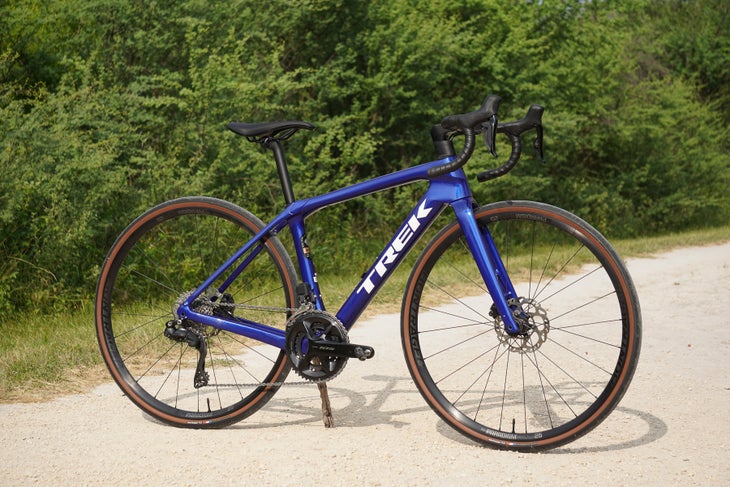
Quick hits: Seven things to know about the Trek Domane SL
- The Trek Domane lineup features three main framesets: the top-tier Domane SLR , the aluminum Domane AL , and this mid-range Domane SL carbon road bike. The Domane RSL is available as a frameset.
- Every Domane features fully internal cable routing through the headset, though the stem functions similarly to a traditional stem.
- The latest Domane SL and SLR bring a new internal storage compartment for a tube, tools, and an included neoprene storage sleeve.
- Max tire clearance is a quoted 700c x 38 mm.
- A new Domane SL frame weighs a quoted 1391 grams, 300 grams lighter than the previous Domane SL.
- Domane SL features a rear IsoSpeed decoupler to improve seated comfort, though it is no longer adjustable.
- Domane SL is available in seven sizes to fit riders between 4’11” to 6’5”.
Frame details
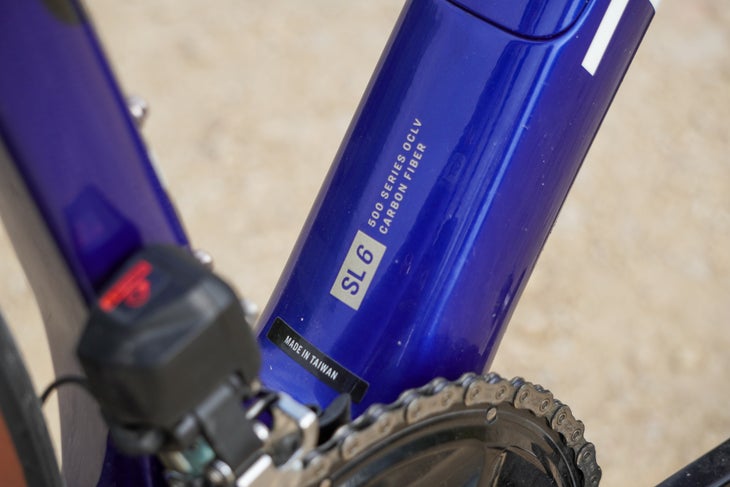
The Trek Domane is known for being an approachable road bike. Much of that comes down to handling geometry that values straight-line stability over race bike agility. Its fit geometry is more accommodating of a non-competitive cyclist than other bikes in its category.
The IsoSpeed seat tube flex system isolates riders from road vibration in a way few other bikes do. And while there are a number of changes to the latest Domane SL, most of those characteristics carry on.
IsoSpeed is a critical component of any recent Trek Domane road bike. Previous generations really went for it, offering not only adjustable rear IsoSpeed systems but even a front-end system to balance comfort between the two ends. This latest system essentially overhauls IsoSpeed, largely for the better.
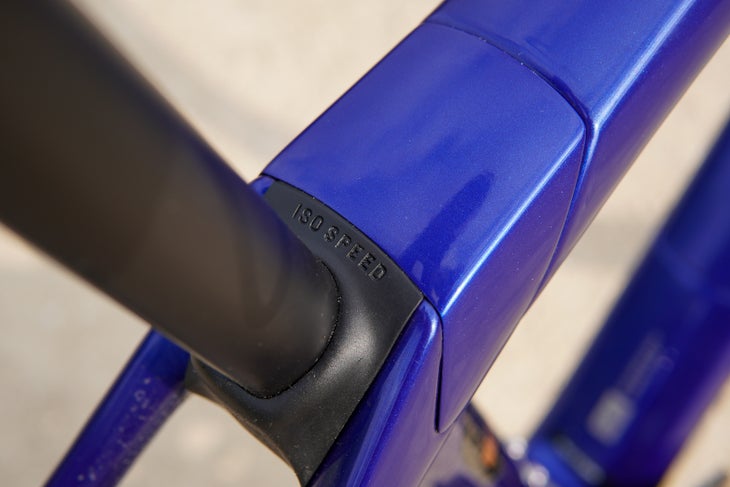
Most notable is that this latest iteration is said to offer as much flex as the softest setting in previous IsoSpeed systems while using a simpler D-shaped seat post. Previous Iterations of IsoSpeed used a carbon seat mast to offer the flex they wanted, but it was far more fiddly to use than this simpler system.
The front IsoSpeed system is gone, as the swap from 28 mm to 32 mm is said to be plenty comfortable. The fact that this system has far fewer moving parts and wear items should result in fewer creaks and durability issues compared to previous-generation systems. Trek says the system needs no servicing for the lifetime of the bicycle, and I never had issues with it in my time with the bike.
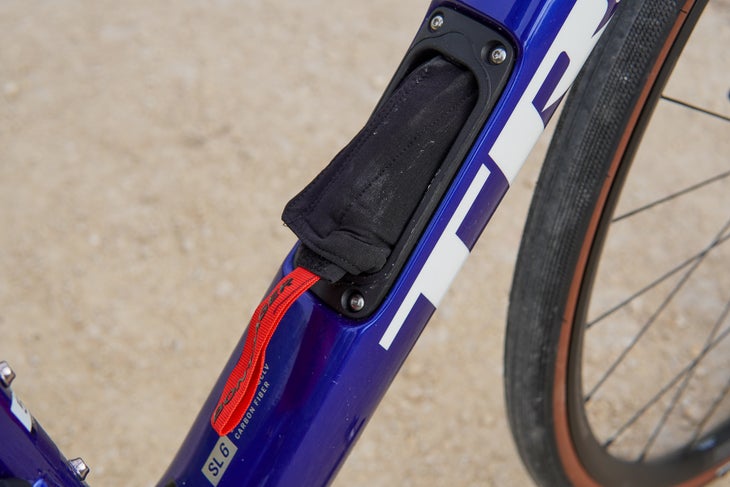
The Domane SL isn’t a particularly light bike. Some of that comes from the addition of a downtube storage hatch located under the bottle cage mount. Inside is a neoprene mini tool sleeve as well as plenty of space to add more snacks and perhaps a vest should you need to. It’s a genuinely useful storage area, with a sturdy latch and hatch system.
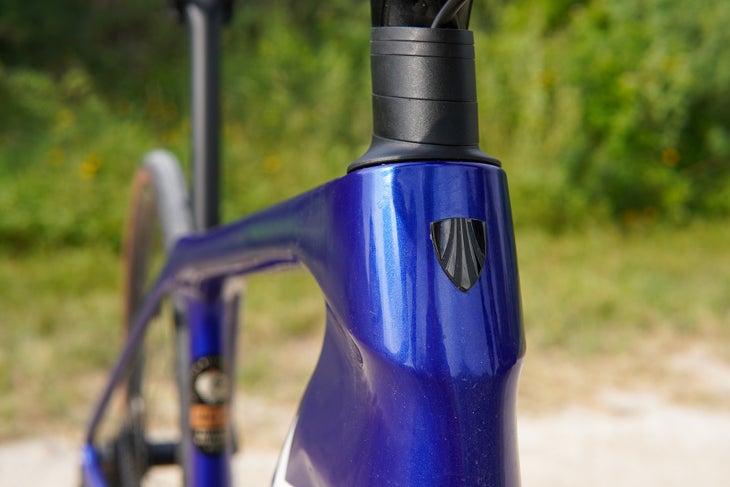
Trek’s Domane continues with internal cable routing, though this system is among the more refined systems I’ve seen and worked with. Cables are external at the bars until they’re routed under the stem, leaving some slack to play with stem height. And while the spacer profiling limits what types of stems you can swap with, doing the swap itself is an easy enough process that almost anyone can manage.
The internal routing system itself is one of the better setups I’ve seen. A guide at the inside of the downtube includes a holster for the Shimano Di2 battery, with guides for brake hoses and cable housing easily accessible from the downtube storage hatch. It’s easy to work on, all things considered.
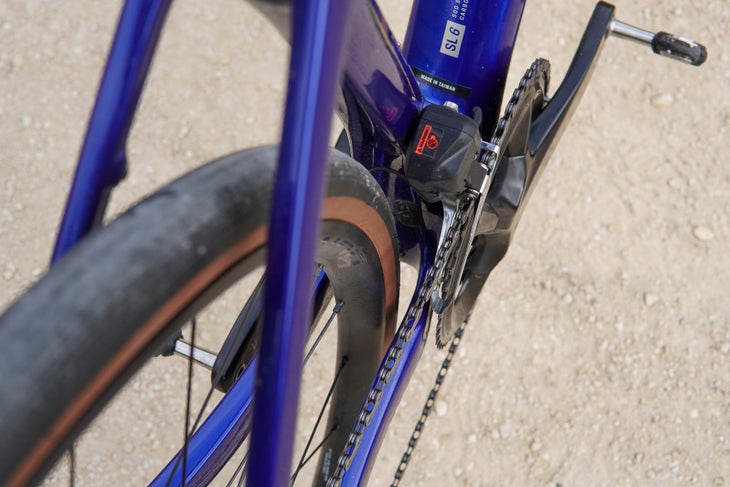
Tire clearance has always been a strong suit of the Domane, and that hasn’t changed. Max clearance is a quoted 700c x 38 mm tire. I was able to fit a 40 mm (42 mm width as measured) Pirelli Cinturato Gravel H tire front and rear without rubbing. That clearance makes light gravel and dirt road riding doable, but it would be problematic on a muddy or chunky ride.
Other bits of note include the use of a T47 threaded bottom bracket, the addition of top tube bag mounts, and hidden fender mounts. The frame gets its own integrated chain keeper, a nice touch that indicates the general user-friendliness of the bike.
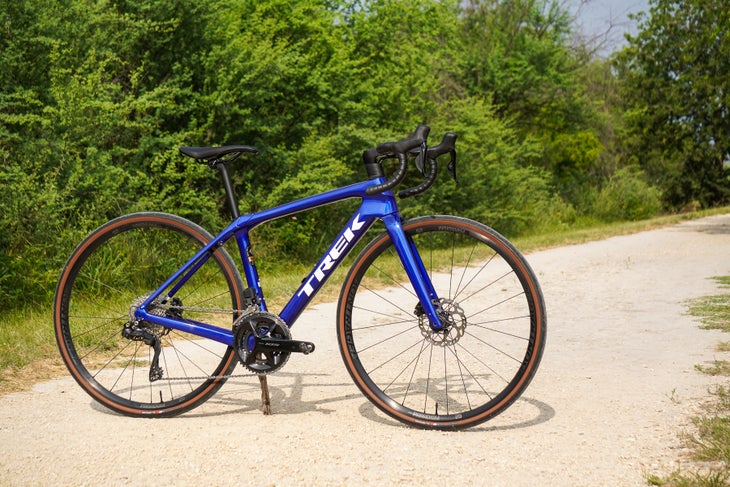
The build brought in for review was the Trek Domane SL 6 Gen 4. The highlight of the bike is the Shimano 105 Di2 drivetrain. The Bontrager Paradigm 25 wheels feature tubeless-ready alloy rims with a wide 25 mm internal width. The 32 mm Bontrager R3 Hard-Case tires, Bontrager Verse Short saddle, and Bontrager alloy handlebars complete the build.
A size 56 cm bike has a quoted weight of 8.62 kg (19 pounds. My 50 cm build weighed in at 8.5 kg (18.73 pounds) without pedals and accessories but with tubes in the tires.
The Domane has a reputation for being an upright road bike with handling that might be best described as stable. While the bike is stable, the geometry is far more agile than you’d expect.
Trail figures are around 59 to 61 cm across just about every size but the 44 cm bike. Handling geometry is quick enough for most people, though the low 75 to 80 mm bottom bracket drop and 420 mm chainstays add some straight-line stability back.
Fit geometry and rider positioning can be considered as upright, with a taller stack height and short reach dimensions. These numbers are taller and shorter respectively than even most all-road bikes, but I’d argue the numbers are realistic for most riders. Those looking for a more than 6 cm of saddle to bar drop (particularly on small sizes) will be better suited to something like their Emonda or Madone road bikes.
Standover heights across most sizes are about as low as I’ve seen on an endurance road bike, which is helpful for the height-challenged among us.
Riding the Trek Domane SL
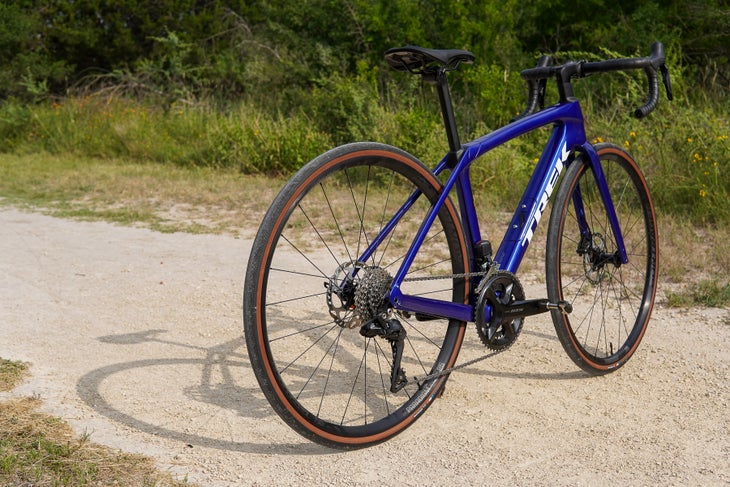
The value of the Domane doesn’t necessarily come from its cost or its tech-forward features, but rather in its promise of being a comfortable, approachable road bike. That isn’t lost here: the Domane is one of the most approachable road bikes you’ll find and an easy recommendation for anyone looking for a road bike.
The Domane rides as smoothly as it always has on smooth tarmac and chip-seal. The way the bike goes about smoothing out those small, constant vibrations is impressive. Roads I remember as feeling particularly jostling felt far smoother, both at the saddle and at the bars.
Much of that smoothness comes down to the 32 mm wide tires, which are wider than you’d find on most other all-road and endurance bikes out of the box. That said, narrower tires didn’t detract much from the bike’s smoothness over chip seal-type surfaces. Stay seated, and let the rear end of the bike do its job.
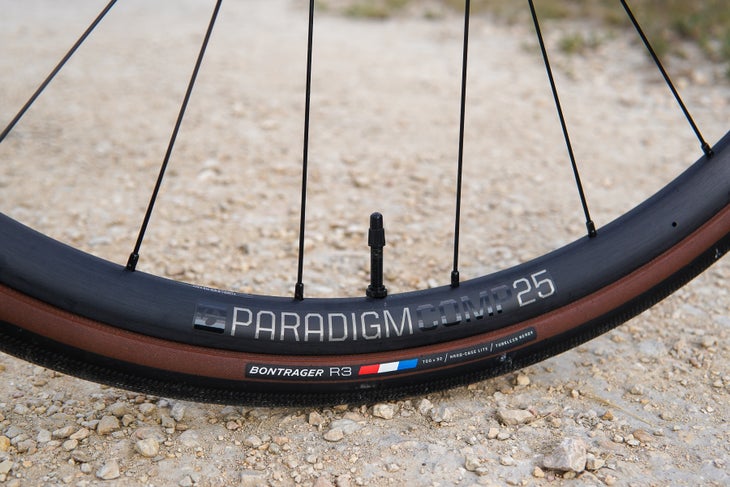
As much as I liked the Domane SL, the bike didn’t feel as eager as I would have hoped. Steeper climbs and even pedaling from a stop indicated that much of that came down to rotational weight. But with a set of carbon wheels and a good set of 30 mm tires, the Domane really woke up.
A set of Hunt Aerodynamicst 44 wheels and 30 mm Vittoria Corsa Pro Control tires gave the bike the feel of a bike far more willing to not only get up to speed but maintain it as well. If you’re itching to make an upgrade, rest assured that a decent set of carbon wheels – like their own Bontrager Aeolus Pro 37V – wake the bike up dramatically.
The stock Bontrager wheels are serviceable otherwise. They’re on the heavy side at over 1950 grams with tubeless tape and valves, but spoke tension and overall build felt like they were going to last. As serviceable as they are, however, it helps to know that you a swap to mid-range Hunt carbon wheels cut over 1 pound (520 grams) from the weight of the bike.
The Bontrager R3 Hard-Case Lite tires are grippy and seem to be long-lasting. That said, I felt the tires felt stiff and slow. A simple tire upgrade alone makes the bike feel considerably more eager.
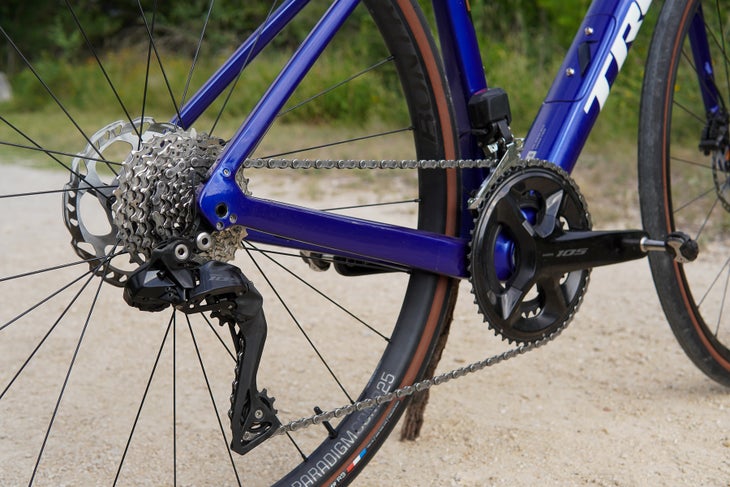
I found little fault in the rest of the build kit. Shimano 105 Di2 works phenomenally, with quick shifts and gearing plenty low for fondos. The Bontrager Verse Short saddle is wonderfully supportive for how soft the saddle feels. The Bontrager short-reach handlebar choice deserves some praise; its 38 cm width in a 50 cm frame is smaller than most product planners choose but the right size for smaller folks.
The Domane SL rubbed me the wrong way
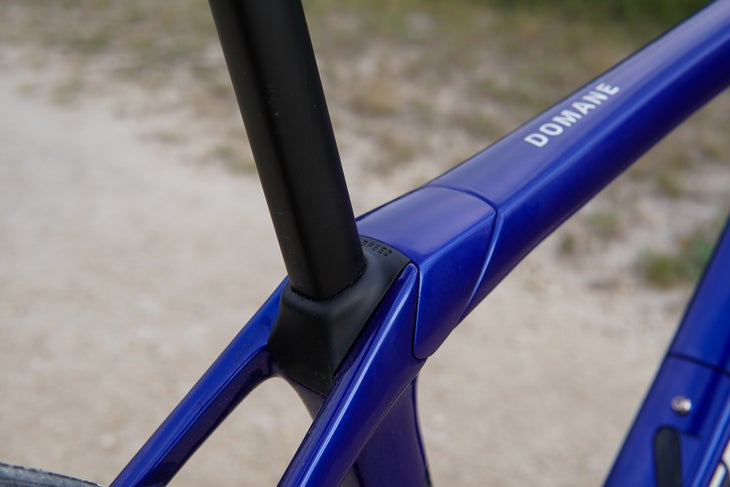
There was one notable fault I found with the bike, however: the IsoSpeed cover rubbed the inside of my legs on a 125 mile (200 km) road ride enough to create a rash.
A bit about me: I am fairly small at 5 foot, 6 inches and 130 pounds (59 kg) in kit. My legs aren’t particularly big, but they aren’t as lean as they could be either. I’ve received a professional fit and matched that fit onto the Domane SL to ensure my cleats (and feet) are roughly where they should be.
Here’s what the lead engineer of the Domane SL had to say:
“The Domane SL maintains the same thigh clearance as used on other road bikes. How far the max width carries up the seat tube can very slightly between models and this variation may be what you are experiencing compared to another Trek road bike. If it is an issue you could try going to a smaller size which moves his saddle up compared to the frame.”
The Domane SL top tube is wide, particularly as it approaches the seat tube junction. It’s wider at the seat tube junction than any other road bike I’ve ridden this year, though I don’t usually have problems with wide top tubes. The design weakness comes is the location of the IsoSpeed cover; the plastic cover seemed placed perfectly to rub the inside of my legs just above my knee raw.
Could I have sized down? Not really. I was on a 50 cm frame with the seat post extended to its minimum insertion point. Any smaller and I would need a drastically longer stem that would alter the handling Trek intended the Domane to have from the factory. Ultimately, some helicopter tape along the seam stopped the rub, but should I have to do that with a new frame?
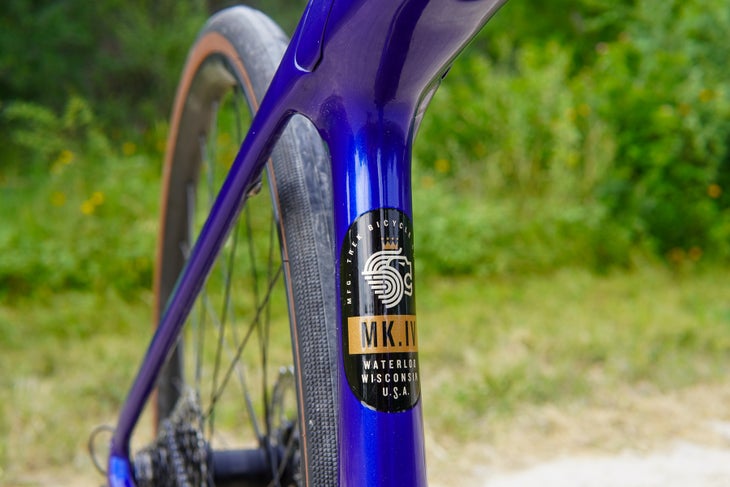
Like as with any other bike, give the Domane a test ride before you buy it, particularly if you’re smaller or have bigger thighs like I do. I suspect I am in a very, very small majority of folks to experience this. Considering how many Trek bike dealers there are in the world, it should be easy enough to take the bike for a spin.
The Trek Domane SL 6 vs the competition
Call it an endurance road bike or an all-road bike, this segment is one of the most competitive segments you’ll find. The three endurance road bikes I’ve ridden in recent memory are the BMC Roadmachine , Canyon Endurace , and Cannondale Synapse . The Domane offers the most upright fit geometry, but all are fairly comfortable to ride for the average cyclist.
Surprisingly, I found the Domane to have the quickest steering of the bunch. Despite that, it feels about as stable in a straight line as the other bikes. Add in the IsoSpeed system that seemed to smooth out chipseal as well if not better than the other bikes too as well as its internal frame storage and the Domane starts to stand out.
The Endurace edges the other three bikes out on value for money, offering Shimano Ultegra Di2 and nicer tires at a lower price point. However, I wouldn’t be surprised if you were able to find the Trek, BMC, or Cannondale on sale at a local bike shop, in which case you start to find good value for the money.
I would also take a close look at the Trek Domane AL , one of the most impressive bikes I’ve ridden in recent memory. It might lack the ultimate polish and ride smoothness of the carbon bikes, but the handling, rider fit, and wide 32 mm tires are still there. It’s a fantastic bike.
Choose the Domane SL if you’re looking for about as smooth a ride as you’ll find, want internal frame storage, and need the ultimate warranty support that comes from seemingly having a Trek dealer on every block.
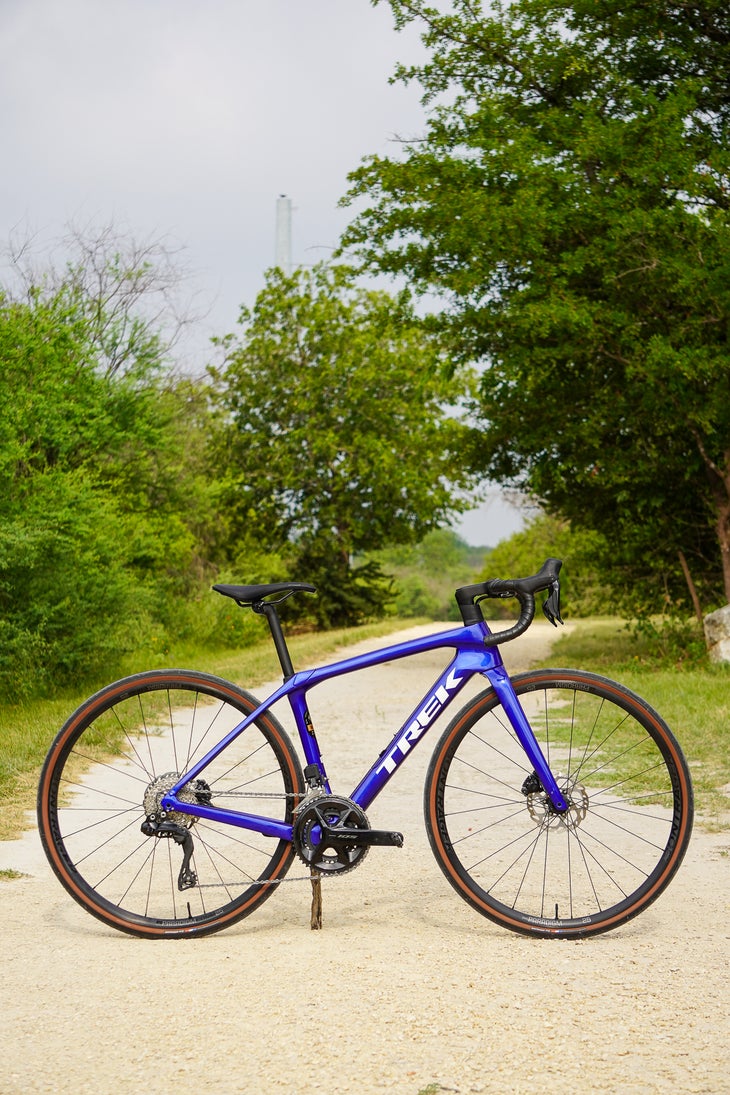
Long story short, I came away surprised by the bike. The latest generation Domane SL is every bit as smooth as you’d expect a Domane to be, and an approachable bike too. There’s a reason why it’s a go-to recommendation for most cyclists: the Domane reliably ticks every box for most road cyclists.
You pay for the privilege of riding the Domane, but considering how smooth the bike is over tarmac, I’m sure a vast majority of riders will be more than happy with it. The clearance for gravel bike tires, the internal frame storage, and the general refinement of the bike are all icing on what is a truly versatile all-road bike.
Just make sure you ride it so it doesn’t rub you the wrong way.
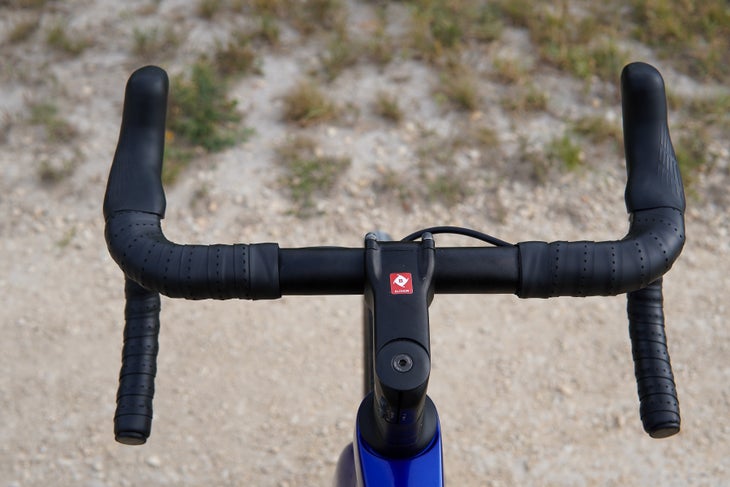
Popular on Velo
- Weather Guides For Every Country In The World
- Algeria: Two Week Journey
- Cairo Travel Guide
- Best Time to Visit Lesotho
- Burkina Faso
- Central African Republic
- Côte d’Ivoire (Ivory Coast)
- Democratic Republic of the Congo
- Equatorial Guinea
- Guinea-Bissau
- Best Time to Visit
- Entry Rules and Visa requirements
- Salt Cathedral of Zipaquirá
- Dominican Republic
- Antigua and Barbuda
- El Salvador
- Afghanistan
- Bahrain Travel Guide
- The Cook Islands
- Aktau, Kazakhstan: Travel Guide and Tips
- Roadtrip in Western Kyrgyzstan
- Journey around Issyk-Kul
- Pakistan travel guide
- Albania Road Trip Guide
- Albania’s Entry Rules
- Yerevan Travel Guide
- Faroe Islands
- Suburbs of Paris
- Batumi Travel Guide
- Tbilisi Raves
- From Mestia to Ushguli (Svaneti) Trekking Route
- Transadjarian Highway
- Peloponesse Road Trip Guide
- Milan Travel Guide
- The Ultimate Venice Guide
- Modern Milanese architecture
- Budva Travel Guide: Montenegro’s main resort
- Montenegro Road Trip Guide
- Transylvania
- Yakutsk Travel Guide
- Journeying Through History: The BAM Railway Experience
- Veliky Ustyug Travel Guide: Meet the Ded Moroz
- Belgrade’s Cultural Guide
- Belgrade Off the Beaten Path
- Road Trip Guide
- Istanbul 🇹🇷: Hand-Painted Signs from a Century Ago
- From Grodno to Brest: a roadtrip
- Bosnia and Herzegovina
- Holy See (Vatican)
- Liechtenstein
Sakhalin: Your Essential Guide to Russia’s Enigmatic Eastern Island
- January 14, 2024
A Journey Through Giant Burdocks, Wild Bears, and the Echoes of Ancient Japanese Temples
From the most dreaded place of exile in the Russian Empire to a Japanese industrial base and one of the most attractive and inaccessible places for domestic tourism in Russia.
Table of Contents
An island that was Russian, then Japanese, and then Russian again
From the 17th to the mid-19th century, it was believed that Sakhalin was a peninsula. This misconception firmly established itself on the maps of the time, as navigators failed to circumnavigate the island. The proximity of Sakhalin’s southern tip to the mainland created a false impression of being impassable for ships. An additional complexity arose from the fact that the route taken by ships from the Russian Empire involved passing through a narrow strait, which Nevelskoy managed to navigate only in 1849.
For a long time, people did not believe Nevelskoy, but he insisted that he had discovered a route through the strait, for which he became something of a hero in Primorye. Monuments and plaques dedicated to him can be found in Yuzhno-Sakhalinsk, Vladivostok, and Khabarovsk. The H4H creative association created a graphic novel based on this story, which won a cultural initiatives contest and became part of the interior of the Khabarovsk Airport. By the way, the Sakhalin region is the only Russian entity entirely located on islands.

The remote and isolated location of the island during the Russian Empire was used as a natural barrier, and it became the site of penal colonies for hard labor prisoners. Its geographical position led to Sakhalin’s hard labor being regarded as particularly cruel.
During the period of the island’s development, Russian ships followed the Amur River and reached the island from the north, where the oldest port, Alexandrovsk, was founded. The Japanese attempted to develop the island from the south, entering through the Kuril Islands (part of the Sakhalin region) and Aniva Bay. For a long time, the Kurils were inhabited by the Ainu, representatives of a small indigenous people. The very word “Kurils” comes from the Ainu: “kuru” means “man.”
In the 17th century, Japan conducted its first expeditions towards the islands and began their development. Russia reached them later. The first mentions of the islands in Russian language date back to the late 17th century. For a long time, Russian, Dutch, Japanese, and Anglo-French navigators studied the islands, landed on them, and disputed their territorial ownership. However, only Russia and Japan managed to establish a foothold. To end the territorial disputes, the governments of the two countries signed an agreement under which the Kuril Islands went to Japan, and Sakhalin to Russia, which continued to develop the island mainly from the north. After the Russo-Japanese War of 1904-1905, which ended in Russia’s defeat, the southern part of Sakhalin became part of Japan as the Karafuto Prefecture.

Until the second half of the 20th century, the island was owned by Japan and was quite successful in developing its resources. A huge number of mines were opened, several cities and lighthouses were built. In particular, the current regional center, Yuzhno-Sakhalinsk, was the former Japanese city of Toyohara. The famous Aniva lighthouse, now considered a symbol of Sakhalin, was built by Japanese engineers. After Japan’s defeat in World War II, the island passed to the Soviet Union. Contrary to history, the main life of the island moved from the north to the south. Alexandrovsk, which was convenient to reach by water, lost to Yuzhno-Sakhalinsk with its infrastructure built by the Japanese, connections to neighboring cities, and airport. Interestingly, before leaving, the Japanese buried and hid the mining sites, and locals say that not all the old mines have been found yet, and they are sometimes stumbled upon during walks.
Because the island belonged to three different countries in just over a hundred years, it did not have time to develop any significant urban infrastructure. The cities lack outstanding architectural monuments and unique museums. However, some unusual Japanese architecture has remained. Meanwhile, Sakhalin compactly houses incredible natural attractions. Here, one can climb through forests and bamboo thickets to breathtakingly beautiful mountains as if outlined in graphite, and through a mountain pass reach the sea, into which clear mountain rivers flow with fish splashing in them.

The Ainu and Nivkh: Inhabitants of Sakhalin
For a long time, the island was mainly inhabited by the Ainu and Nivkh peoples. These ethnic groups are very different, making their coexistence as unusual as the neighboring of birch and bamboo on the slopes of Sakhalin’s mountains. Both are isolate peoples . However, the Ainu belong to the Australoid race, while the Nivkh are Mongoloids (the main population of Asian territories). It’s fascinating how representatives of different races have coexisted for ages on a small piece of land at the edge of the world.
There is no single version regarding the origin of the Ainu, leading to a multitude of theories — both scientific and conspiratorial. One theory suggests that the Ainu are the ancestors of the indigenous population of Australia, remaining in the north after continental migration. Some researchers write that the Ainu are the forebears of the Japanese. This theory is supported by the fact that before Japanese expansion, the Ainu mainly inhabited the Japanese island of Hokkaido. However, the Ainu suffered greatly from Japanese imperialism, and their culture and language were almost completely destroyed in the 19th and early 20th centuries. Now, there are just over two thousand Ainu living on Sakhalin.

The Nivkh are among the indigenous small-numbered peoples of the north. They suffered less from Japanese rule. However, during the Soviet era, they experienced a difficult phase of literacy development, destruction of tribal communities, and relocation to cities. About 2,200 Nivkh live in the Sakhalin region and another approximately two thousand in Khabarovsk.

During the Karafuto period, Japan brought captured Koreans to Sakhalin for hard labor. By the mid-20th century, the Korean population of the island was about 45,000 people. For comparison, the current population of Yuzhno-Sakhalinsk is 180,000. This large number of people, deprived of their homeland, was forced to adapt to life first under Japanese and then Soviet rule. In the USSR, Koreans were issued passports, and there were national kindergartens and schools. However, Sakhalin Koreans did not feel part of the larger community of Soviet Koreans (Koryo-saram) and struggled to integrate. Moreover, they were considered members of an ‘unreliable nation’ because they had lived in the Japanese Empire.

In the late 1990s, three countries – Russia, South Korea, and Japan – began a repatriation campaign for the first generation of Sakhalin Koreans (born before August 15, 1945) to their historical homeland. Now, about 3,500 repatriates from Russia live in South Korea. Under the program, the Korean government provides medical insurance and a monthly allowance to the repatriates. The Japanese government, in turn, buys housing (apartments up to 40 m²) and covers transportation costs. Additionally, every two years, Sakhalin Koreans who have moved to their homeland have the right to visit Sakhalin for free, funded by the Japanese government. Most Sakhalin Koreans settled in the city of Ansan , where 500 apartments were specially built for them.
Korean influence is weakly traced on Sakhalin: many Sakhalin Koreans no longer know the language and do not associate themselves with Korea. However, there are several authentic restaurants (for example, “Koba” ) on the island where you can try traditional dishes.
Yuzhno-Sakhalinsk — the capital and base for exploring the island
The city is predominantly characterized by typical Soviet architecture, with almost no remaining Japanese buildings. This is because during the Soviet period, the city was radically rebuilt after being liberated from ‘imperialist Japanese rule.’ Many buildings were demolished, and from the few that remained, some were turned into museums. Perhaps the main thing that has been preserved from the Japanese period is the layout. The city was founded from scratch near the Russian village of Vladimirovka, and Chicago was chosen as the model for its layout. Toyohara was divided into four parts by two main streets, O-dori (now Lenin) and Maoka-dori (Sakhalinskaya).

Japan established itself thoroughly on the island. In Toyohara, trade routes converged, new bays were developed, and roads were built. The city’s population grew steadily. Initially due to the military garrison, and later due to a paper mill, a sugar and distillery plant. Now, the buildings of the former Japanese factories are abandoned. Many of them can only be accessed with rare tours, while others are completely closed. However, their presence is still recalled by street names, such as Paper Street.

Another building in the Neo-Japanese style is the Karafuto Governorate Museum built in the 1930s (29 Communist Avenue). It now houses the Sakhalin Regional Museum . And in the former bank of colonial development, there is the Art Museum (137 Lenin Street).

Several other iconic buildings constructed by the Japanese have been preserved: the central hospital of Toyohara (41 Chekhov Street), the conference hall of the Karafuto Governorate (30 Dzerzhinsky Street), and the Toyohara City Hall (41 Communist Avenue). The Sakhalin Railway Museum in Yuzhno-Sakhalinsk is distinct from many similar museums in Russia due to its exhibits. This is because the island long maintained the Japanese standard of railway gauge, which differs from the Russian standard. Accordingly, the rolling stock was entirely different.
If in Vladivostok everything is named after the Far Eastern explorer and writer Vladimir Arsenyev, then in Yuzhno-Sakhalinsk, mentions of Chekhov are everywhere. At the end of the 19th century, Sakhalin was both the most dreaded place for exile to hard labor and one of the most tempting corners of Russia, which was not so easy to access. Chekhov received an editorial assignment and embarked on a ship along with prisoners, military personnel, and sailors to the most remote point of the empire. In his notes, which Chekhov compiled under the title ‘The Island of Sakhalin,’ the writer talked about many things: the geography and climate of the island, the life of the convicts, and ordinary residents. This book caused a great resonance at the time, and even now it was very interesting to read it while traveling to Sakhalin: some things have changed drastically, while others have remained the same. Now in Yuzhno-Sakhalinsk, there is even a museum dedicated to this one book, which turned out to be so significant for the island.
GoSakhalin is the website of the Sakhalin Tourist and Information Center. And in their official Telegram channel , you can find announcements of affordable excursions shortly before they start.
In any case, for travelers, Yuzhno-Sakhalinsk remains primarily a hub and a place of rest. Here they return for the night and dinner, and it seems that real adventures begin outside the doorstep.
Surrounding Area
10–20 kilometers from Yuzhno-Sakhalinsk
The main reason people visit Sakhalin is for its unique nature. Mountains, forests, rivers, lakes, and the sea, all on a small piece of land. In one day, you can travel from the Sea of Okhotsk to the Sea of Japan, cross several climate zones, see bamboo groves, birches, and spruces in one place, spot a running fox and a swimming orca. The island’s landscapes can boldly compete in Instagram appeal with Iceland or Norway.
Within Yuzhno-Sakhalinsk alone, there are about 30 kilometers of marked ecotrails, with brief descriptions and routes available on the official tourism portal. I also found an ecotrail in Nevelsk, which is not mentioned on the official website.
The ecotrails in Yuzhno-Sakhalinsk start from the ‘Mountain Air’ ski center on the sopka (a term for mountains in the Far East) Bolshevik. There are five in total: ‘Children’s’ (2.7 kilometers), ‘Eight’ (8 kilometers), ‘Northern Ring’ (9 kilometers), ‘Russian’ (3.2 kilometers), and ‘Yelanka’ (5 kilometers). You can take a cable car to the start of the trails and then slowly descend through the forest and park to the city. However, the lift does not operate in rainy and windy weather.

Hiking the ‘Eight’ trail took me no more than three hours, including stops to catch my breath and take photos. Every kilometer and a half along the route, there are benches. From the top of the mountain, there is a view of Yuzhno-Sakhalinsk, and it seems you can see a piece of the Sea of Okhotsk.

Chekhov Peak
The route to Chekhov Peak is a high-mountain trekking path that requires a certain level of physical fitness. Chekhov Peak has an elevation of 1045 meters, with an absolute altitude gain of 752 meters. The trail is narrow and slippery in places, hardly suitable for children or people with limited mobility.

Chekhov Peak is part of the Susunai Range, which supports Yuzhno-Sakhalinsk from the southeast. You can exit from Gagarin city park to the foothills in about half an hour. The ascent to the peak itself cannot be missed: a marked trail and informational signs lead to it. On particularly steep ascents, ropes are hung for safety, but it is possible to walk up the slope without them.
In late spring, the forest trail has many streams, as well as May primroses and butterflies. The foothills are scattered with rare, incredibly large, and wonderfully fragrant marsh callas. Halfway to the peak, bamboo thickets are encountered, through which birches break through. This is also a kind of magic because, as a biologist friend explained to me, birch and bamboo are not supposed to coexist in the natural environment, but somehow they manage to do so. Occasionally, spruces are encountered — not tall, but very fluffy. Closer to the top, the vegetation becomes sparser, and the impressive views of the sea, mountains, and lakes open up from the height.

- The entire hike takes five to six hours.
- Even in summer, there is snow on the summit. In the afternoon, it starts to melt, making it more difficult to walk.
- Don’t forget to bring food and water.
- Wear boots with covered ankles, a jacket, and a head covering.
- Inform your family and friends, and someone living in Sakhalin, before setting out on the route. If you’re traveling alone, you could notify, for example, the hotel receptionist or roommates in a hostel.
- Snakes and bears are found around the trail. Watch your feet and try to make as much noise as possible. For example, play music on your phone and sing along occasionally.
- The ascent to Chekhov Peak can be the start of a journey to the village of Lesnoye on the shore of the Sea of Okhotsk. The distance to the village is 27 kilometers. With good preparation and an early start from Yuzhno-Sakhalinsk, this distance can be covered in one day.

Mud Volcano in Klyuchi
A mud volcano is an eruption on the earth’s surface of clay masses, mineralized waters, and gases. The mechanism of formation of these volcanoes is not fully understood. According to the existing theory, such volcanoes are formed near oil fields.
The mud volcano in Klyuchi consists of a mud field about 200 meters in diameter. There, you can see about 20 points of activity, resembling miniature volcano craters. This mud volcano became active in 1959, 1979, 2001, and 2011 (the last time due to a strong earthquake in Japan). During these eruptions, mud columns reached several tens of meters in height. Bus 189 goes to Klyuchi from Yuzhno-Sakhalinsk. The distance from the village to the top of the volcano is nine kilometers and takes about two and a half hours to walk.

Ecopark in the Vestochka area: Frog Rock, Aikhor Waterfall, ‘Sunny Glade’ Recreation Park
Not far from Yuzhno-Sakhalinsk, there is a fairly large ecopark, known primarily for the Frog Rock outcrop. An outcrop is a remnant of harder rock around which softer rock has eroded over time. Outcrops are often known for their unusual shapes and are natural monuments. Frog Rock is part of a series of rocks standing one behind the other. This was once the seabed of an ancient sea, and fossilized shells can be found in its vicinity. From the top of the rock, amazing views of the Aniva Bay, Tunaycha and Changeable Lakes open up. This place was sacred to the Ainu, the indigenous inhabitants of the island.

The trail to the ‘Sunny Glade’ ecopark begins behind the ‘Electron’ culture house. Despite its name, it is not a city park, but a full-fledged forest with laid-out paths. There are houses, glades with tables for rest where you can cook barbecues, and wooden walkways leading to various attractions. These are all paid services.

The path to Frog Rock outcrop goes along the Komissarovka River. In areas of spring flooding, callas bloom and bamboo grows. The outcrop is located on a hill, with a total elevation gain of about 300 meters. The road is quite challenging, usually taking from an hour to an hour and a half. The higher you climb, the more you can see: the sea, the mountain gorge, the road to Vestochka. In the same park is the Aikhor Waterfall, which is also a short climb away, but along a less well-maintained trail. You can plan a whole day to visit Vestochka and even spend the night, without returning to Yuzhno-Sakhalinsk.

Vestochka is three high-rise buildings on one side of the road and a cottage settlement on the other. It is part of Yuzhno-Sakhalinsk, though located 15 kilometers from the main part of the city. A taxi there costs about 1000 rubles and takes 40 minutes. About a kilometer after turning off the main road, the asphalt ends and a terribly dusty dirt road begins. If you’re lucky, you can catch a bus that runs three times a day.
What else to see on the island
40 kilometers from Yuzhno-Sakhalinsk
The oldest city in the south of Sakhalin, founded by Nevelskoy’s expedition. Here you can find a huge number of monuments dedicated to sailors, naval battles, and ships. The most significant monument in the city in recent decades has become the stele dedicated to ‘Koreans interned by the Japanese in Sakhalin, who never returned to their homeland,’ located on Mount Sorrow, created through the efforts of three countries’ governments (Russia, Japan, and Korea).

In Korsakov, some Japanese heritage has been preserved: the former building of the Hokkaido Takushoku Bank, a colonial development bank (Sovetskaya Street, 3), trade warehouses in the port, a document storage facility ‘Bunsyoko’ (Krasnoflotskaya Street, 1), a couple of rusty fire hydrants, and remnants of Shinto temples in the form of pillars with hieroglyphs. One of the local nighttime entertainments is watching the lights of the gas processing plant.
How to get there. Three electric trains a day, the journey takes just over an hour, and the ticket costs 75 rubles (0.74 euros).

Bird and Giant Capes
90 kilometers from Yuzhno-Sakhalinsk
Two capes, recognized as natural monuments in 1990, along whose coasts are many wind and wave-carved grottoes, caves, arches, and columns of various sizes and whimsical shapes, among which colonies of sea birds reside.
The place is not very close, but it’s very picturesque at any time of the year. In the area of one of the rocks, there is a pool where, during the salmon spawning period, you can observe a fascinating spectacle — a huge gathering of pink salmon.
Many tourists stay on the coast overnight to witness the sunset and sunrise. Near Cape Giant, there is a toilet, parking, and a rest area with benches.
How to get there. The journey from Yuzhno-Sakhalinsk goes through the village of Okhotskoe, where you can buy fresh crabs, and takes about three hours one way. The road is fully passable only by high vehicles like Mitsubishi Pajero, Suzuki Jimny, as the last ten kilometers of the route have deep puddles, potholes, small cliffs, and rivers.

Nevelsk and Steller Sea Lions
Nevelsk is nestled between mountains and sea. The rocky mountains and the coast, which consists of small stone needles and shells, in every way explain why Chekhov so often mentioned in ‘The Island of Sakhalin’ how harsh the land of Sakhalin is.

Steller sea lions are the largest of the eared seals. One of their habitats is the breakwater in Nevelsk. As soon as you arrive in the town, the smell from the Steller sea lions’ haul-out site hits you. ‘They eat there, live, give birth to their young – that’s why it smells,’ the locals explain. Another feature is the noise. Steller sea lions are very loud!
You can view the sea lions from the central square, where binoculars are installed. However, tourists usually hire a boat and approach the haul-out site to get a closer look at the seals. You can see how the Steller sea lions bark, lie in the sun, jump into the sea and, most interestingly, try to jump back. The views from the square through binoculars are not as detailed and impressive. A place on the boat will cost 1000–1500 rubles (9.81 – (14.71 euros). You can also buy a tour from Yuzhno-Sakhalinsk for 3500 rubles (34.33 euros). The most animals are present in spring and early summer. In autumn, there may be a couple of dozen individuals left.

From the embankment, you can observe the huge kelp laminaria floating in the sea. Some travelers catch them themselves and eat them. Although dishes made from seaweed are found in cafes and also sold in stores. Signs are installed on the shore indicating where to run in case of a tsunami. The last major earthquake with waves was recorded in 2007. Many houses were destroyed and two people died. The most famous Sakhalin tsunami was the 1952 tragedy , when the aftermath of the earthquake almost completely destroyed Severo-Kurilsk.
How to get there. From the bus station (Karl Marx Street, 51b) in Yuzhno-Sakhalinsk, buses go to Nevelsk, the ticket costs 300 rubles (2.94 euros), and the journey takes about an hour. Tickets can be purchased at the bus station ticket office or from the driver (cash or transfer). It’s not possible to board the bus somewhere in the city, as the bus does not make stops. It’s better to buy a return ticket immediately upon arrival in Nevelsk at the Nevelsk bus station ticket office (Lenina Street, 1). The bus is popular with locals, and there may simply be no seats left.
Remnants of structures from the Karafuto period include the Maoka-Jinja temple with a Japanese-style garden and an abandoned railway built by the Japanese. It used to connect Kholmsk with Yuzhno-Sakhalinsk. Tourists usually come to see two photogenic bridges – Devil’s and Witch’s – and a tunnel in the mountain that makes a full circle inside it. The trail passes along the old rails, and there are many vipers, so one needs to watch their step.
How to get there. The bus to Kholmsk takes two hours, the ticket costs 450 rubles (4.41 euros), with 14 trips a day.

Slepikovsky Cape and Lighthouse
120 kilometers from Yuzhno-Sakhalinsk
At Slepikovsky Cape, there is the only relic grove of Korean cedar on Sakhalin. Also located here is the functioning Slepikovsky Lighthouse, which is a 27-meter tall round tower, connected by corridors to utility and residential buildings.

The cape and lighthouse are named after the commander of the Russian partisan detachment Bronislav Grotto-Slepikovsky, who operated in Southern Sakhalin during the 1904–1905 war. The route to the lighthouse goes through the villages of Yablochnoe and Sadovniki, where some of the best beaches on Sakhalin are located — with the cleanest water and white sand.
How to get there. The cape is located 29 kilometers north of Kholmsk. From Kholmsk to the turn towards the lighthouse, there is asphalt with dirt sections. From the turn to the lighthouse, there is first a dirt road, then beach sand, which is recommended to be driven on with deflated tires. Visiting time is from spring to autumn, as the road to the cape is not cleared in winter.
110 kilometers from Yuzhno-Sakhalinsk
In 1891, when the island had a penal colony, this was the Russian village of Siraroko, named after a nearby Ainu settlement. In 1905, the south of Sakhalin was given to the Japanese, and the village was renamed Higashi Shiraura. Here there were a railway station, a brick factory, and a coal mine. 40 years later, the settlement was renamed Vzmorye.
During the Japanese times, there was the Shinto shrine Higashi Shiraura Inari-Jinja. Only the torii gates remain — P-shaped gates without doors that are placed on the path to a Shinto shrine. These are the only torii on Sakhalin. On the torii, there is an inscription ‘In honor of the 2600th anniversary of the foundation of Great Japan’ — this mythological date was widely celebrated in 1940.

On the way to the torii, you can see the famous giant burdocks and bear’s garlic. Vzmorye is also known as a place where poached crabs are sold along the highway.
How to get there. Two electric trains and one train that start from Yuzhno-Sakhalinsk stop in Vzmorye. Unfortunately, all three are in the evening. You can also get there on passing buses that go to the north of the island.
Tikhaya Bay
140 kilometers from Yuzhno-Sakhalinsk
On one side, the bay is framed by Mount Smely, and on the other side, the majestic Zhdanko Ridge begins. To the left in the bay itself is an island-kekur, which can be reached during low tide, as well as the epic cliffs of Tikhaya Cape. By the way, behind this cape, there are waterfalls that become icefalls in winter. At the base of the bay is the mouth of the Tikhaya River, where during the season you can see the spawning of pink salmon and chum salmon. Bears are aware of this, so they are often encountered here.
How to get there. Buses going to Poronaysk stop in the village of Tikhoye, near which the bay is located. There are four trips a day.

Aniva Lighthouse

The lighthouse has a complex history: there were attempts to maintain it under Soviet rule, but Aniva was so remote from inhabited areas that it was not profitable. Eventually, the lighthouse was switched to autonomous mode, bringing in a radioactive isotope to sustain its operation, and then it was completely closed. To this day, you can find signs on the walls reading ‘Caution, radioactive’. But now this warning is outdated, as the radioactive isotope was removed when the lighthouse was decommissioned. The lighthouse is very beautiful, offering views of the island and sea, and inside you can explore the remnants of rooms and working areas.

On the return trip, tourists are also taken to Mramornaya Bay, where you can also climb a mountain and view the jagged coast of Sakhalin from above. Orcas and whales are often encountered in these areas, most frequently in summer. I would also recommend taking a combined tour in summer to Aniva Lighthouse, the Blue Lakes, and Busse Lagoon, where you can see the amazingly blue waters and try sea urchins.

A kilometer from Novikov is Cape Tri Kamnya (46.320342 143.373006), which can even be reached by car. Four kilometers from the cape is the small Strelka waterfall , which requires a walk. If you stay in the village overnight, you can take a hike to the Blue (turquoise) Lakes (46.359603, 143.471909). On the way, there’s an abandoned Japanese power station. You can extend your route by another 15 kilometers and reach the opposite shore of the peninsula – to Cape Evstafiya. The road from Novikov to Cape Evstafyeva through the Blue Lakes can be driven in a jeep, if there hasn’t been prolonged rain before. But it’s better to ask in advance those who have recently been there, and get the phone number of a local tractor driver in Novikov, so that if something happens, he can pull you out.

How to get there. Getting there independently is almost impossible. The lighthouse is located on a rocky outcrop in the sea, and the nearest land is a high cliff. However, some people do reach Novikovo (the nearest village) by bus or car, and then walk 44 kilometers on foot to Aniva (the name of both the lighthouse and the bay). It takes about one and a half hours to drive from Yuzhno-Sakhalinsk to Novikovo. And then another two hours of rough dirt road to the boat dock. A tour from the company ‘Friends-Hikers’ costs 6000 rubles (58.84 euros) in May (in summer – 7000 rubles (68.65 euros)).
Klokovsky Waterfall
190 kilometers from Yuzhno-Sakhalinsk
Klokovsky Waterfall is one of the highest waterfalls on Sakhalin Island. Its height is variously reported to be 48–49 meters, with a width of up to nine meters. The waterfall is accessible year-round, but is most full in late spring and early summer.

Alexandrovsk-Sakhalinsky

The ‘Tri Brata’ (Three Brothers) rocks are definitely a symbol of Alexandrovsk-Sakhalinsky, and perhaps of the entire island. They are located in the Alexandrovsk Gulf almost opposite Cape Zhonkiyor. From the cape, there is a stunning view of the vast Tatar Strait and the Three Brothers. At low tide, it’s possible to calmly explore all the attractions of the gulf, collect seaweed and shells, see hermit crabs scuttling along the seabed with their shells on their backs, or watch the leaves of laminaria sway. At the strongest low tide, you can even walk to the Three Brothers through the water.

In the 19th century, convicts carved a 90-meter tunnel through Cape Zhonkiyor to service the lighthouse. To reach the tunnel by land, you need to come at low tide. Otherwise, you’ll have to climb the rocks. The tunnel is lined with logs, but there is almost always water at the bottom and a strong wind howls through it. If you pass through the tunnel, you will see the ‘Tri Sestry’ (Three Sisters) rocks and an old lighthouse from the end of the 19th century. All these places are described by Chekhov in ‘The Island of Sakhalin’: ‘Most often we went to the lighthouse, which stands high above the valley, on Cape Zhonkiyor. During the day, the lighthouse, if looked at from below, is a modest white house with a mast and lantern, but at night it shines brightly in the darkness, and then it seems that the penal colony looks at the world with its red eye. The road to the house climbs steeply, winding around the mountain, past old larches and firs. The higher you climb, the freer you breathe; the sea spreads before your eyes, thoughts gradually come, having nothing to do with the prison, the penal colony, or the exile settlement, and only then do you realize how dull and difficult life is down below.’
How to get there. From Yuzhno-Sakhalinsk, there is one bus trip per day – at 12:10. The ticket costs 2200 rubles (21.58 euros), and the journey takes nine hours.

600 kilometers from Yuzhno-Sakhalinsk
The main transit point on the way to the oil refineries. The village might be of interest to those curious to see a harsh northern town living off production: low-rise buildings made of siding and unexpectedly bright murals on the walls of five-story buildings. There is a local history museum in the village (Sovetskaya Street, 3) – it is praised for its excellent exhibition of the Nivkh culture and a monument to Nevelskoy. Also, one of the longest rivers of Sakhalin, the Tym (which translates from Nivkh as ‘spawning river’), flows through the town.
How to get there. A night train goes to Nogliki every day, taking almost 12 hours. The cheapest ticket in a seated carriage costs 1100 rubles (10.79 euros), a compartment – 4100 (40.21 euros). There is even a luxury (SV) carriage for 12600 rubles (123.57 euros).
Where to Stay
Hostels in the Far East are divided into work and tourist types. The former will also accommodate tourists, but the atmosphere there is like a dormitory where their own rules are already established, and you may feel like an uninvited guest. To avoid such a hostel, it’s important to carefully read the reviews, not book the cheapest hostels, not stay on the outskirts or near airports and train stations.
In the Islander hostel , mainly travelers stay, it’s very cozy, with convenient kitchen and showers with toilets. A double room costs 3000 rubles per day, and dorms – from 900 rubles (8.83 euros) per night. If you book directly through the website and for a long term, you can get a good discount.
The ‘Moneron’ hotel is located near the railway and bus stations. It’s a classic budget hotel with small clean rooms. The ‘comfort’ class rooms have a bath, and the hotel provides a complete set with slippers, towels, and a hairdryer. Prices start from 2800 rubles (27.46 euros) per night for a single economy room, while ‘comfort’ costs 4900 rubles (48.06 euros). Breakfast is included in the price.
The ‘Belka’ hotel building is made using Finnish technology in a wooden style from milled timber. The cost of large rooms with wooden walls and huge beds starts from 5800 rubles (56.88 euros). Breakfast is also included in the price. The hotel complex includes a sauna, spa, tavern, and gym.
Near Bussé Bay is the island’s only dome-shaped glamping site. A night for two costs 8000-10,000 rubles (78.46 – 98.07 euros). An extra bed is 2000 (19.61 euros). Each dome has a shower, toilet, and electricity. On cooler days, you can light the stove and sit by the fire with a cup of hot cocoa.

In other towns, apart from Yuzhno-Sakhalinsk, the choice of hotels is quite modest and usually limited to one or two hotels, which cannot always be booked online. They have to be found on the map and booked by phone.
Transport on the Island
Car. If you’re only traveling between cities, there won’t be any problems – the roads between them are mostly paved, and the dirt roads are of more or less good quality. It gets more complicated with natural attractions. Almost all of them are accessed by dirt roads, which not every car can navigate.
In Yuzhno-Sakhalinsk, ‘Yandex.Taxi’ and ‘Maxim’ operate (also in Korsakov and Kholmsk). A trip within the city limits will cost a maximum of 300 rubles (2.94 euros).

Railway. From Yuzhno-Sakhalinsk, about 30 electric trains depart daily. Most of them go to nearby areas like Dalnyaya, Khristoforovka, and Novoaleksandrovka stations – 8–23 minutes travel time.
To other cities, there’s only one electric train per day. It takes an hour to Korsakov and the ticket costs 80 rubles (0.78 euro). To Tomari, it’s four hours and 300 rubles (2.94 euros). To Poronaysk, it’s five hours of travel and 500 rubles (4.90 euros) for a ticket. Long-distance electric trains depart in the evening, as these routes are used by residents of the province who return from work in Yuzhno-Sakhalinsk to their homes.
There is also one train on the island – Yuzhno-Sakhalinsk to Nogliki, 12 hours of travel and 1100 rubles (10.79 euros) for a ticket in a sitting carriage.

Buses. It seems you can reach even the most remote settlements by bus. Often there’s only one trip per day, but at least it exists. To Kholmsk, Nevelsk, and Korsakov, the journey takes about an hour and a half, with tickets costing around 300 rubles (2.94 euros); to Poronaysk and Uglegorsk, it’s four to five hours and 1200 rubles (11.77 euros) for a ticket. You can check the current schedule on avtovokzaly.ru . But it’s always better to double-check by phone: +7 (4242) 72-25-53. The address of the bus station is Karl Marx Street, 51b.
Airplane. Sakhalin has a quite extensive network of airports, and you can fly from Yuzhno-Sakhalinsk to Okha, Zonalnoye, Shakhtyorsk, Poronaysk, Smirnykh, Yuzhno-Kurilsk, and Iturup. Flights are operated by the Far Eastern airlines ‘Aurora’ and ‘Taiga’ . These routes are served by small propeller planes Bombardier and Mi-8 helicopters. Such a flight is an interesting experience in itself. Moreover, some flights are quite inexpensive. For example, to Zonalnoye, Shakhtyorsk, and Poronaysk, tickets cost 2000–3000 rubles (19.61 – 29.42 euros) one way. To Okha and the Kurils – from 6000 rubles (58.84 euros).
Ferry. From Korsakov, ferries run to different settlements in the Kurils every three to four days. The ferry to Kurilsk takes about 22 hours, to Yuzhno-Kurilsk – 22–30 hours, and to Malokurilskoye – about 40 hours. Interestingly, a ticket to any of these settlements costs from 2800 rubles (27.46 euros), available on the website of the ferry company.
How to get there
By plain. To travel to Yuzhno-Sakhalinsk from Europe, passengers typically fly through major transit hubs. Common routes involve flying from a European city to one of the major Russian airports offering direct flights to Yuzhno-Sakhalinsk, such as Moscow’s Sheremetyevo or Domodedovo airports. In 2023 it is only possible to fly to Moscow from major transit hubs such as Istanbul or Erevan. From there, travelers can catch one of the direct flights to the island. Some routes might also include stops or transfers in other large cities in Russia or Asia, depending on the airline and the flight itinerary, for instance, Novosibirsk, Krasnoyarsk, Irkutsk, Ulan-Ude, Chita, Blagoveshchensk, Vladivostok, Khabarovsk, Komsomolsk-on-Amur, Sovetskaya Gavan, and Petropavlovsk-Kamchatsky. There is even one international flight from Harbin, China.
In good weather, on approach to Yuzhno-Sakhalinsk, you can see the Tatar Strait, the Western Ridge, and the city itself. The airport is located within the city limits, and from there, you can easily reach any point by public transport (buses 63 and 3) or taxi.

Ferry. Vanino (Khabarovsk Krai) to Kholmsk (Sakhalin) . Passenger tickets for the ferry are sold at the Vanino railway station or at the ticket office in Kholmsk (Lenin Square, 5). They can also be reserved by phone: +7 (42137) 74088 (Vanino), +7 (42433) 50880 (Kholmsk). The ferries run daily, with a journey time of 18–20 hours. A seat costs 650 rubles (6.37 euros), while the cheapest cabin spot is 1400 rubles (13.73 euros). There is a dining room on board.
I was on the island in early May, and this has its pros and cons. On one hand, it’s already not very cold in Sakhalin at this time, and you can walk around in a light jacket or sweatshirt, and sometimes even just in a T-shirt. At the end of spring, you can catch the largest number of Steller sea lions in Nevelsk (closer to summer they migrate towards Avacha Bay). Also at this time, you can see the forest awakening: streams penetrate it from all sides, in their floodplains swamp callas bloom, meadows fill with primroses, and the hills are covered with bright green bamboo shoots. On the other hand, there is still snow in the mountains, in which you can get stuck while climbing, and the sea, which is not very warm in these areas, is completely unsuitable for swimming.
In summer, Sakhalin is not very hot, the coast blooms with wild roses, the sea warms up a bit, and there is less chance of bad weather when visiting remote attractions. Also, it’s precisely at this time you can see orcas (June – July) and whales (July – August), as well as the salmon spawning.
In winter, snowboarders and skiers come to Sakhalin. The mountains on the island are not high, so they are suitable even for beginners.

Related posts:
- The Vertical Grain Elevator (Silo) in Samara — A Benchmark of Brutalist Architecture
- Kamchatka: “Island” of Volcanoes, Bears, and Red Caviar
- Yekaterinburg: A Comprehensive Guide to the Ever-Young and Protest-Ridden City
- Altai Republic (Russia) Travel Guide: A Journey through Twisting Mountain Roads
Leave a Reply Cancel reply
Your email address will not be published. Required fields are marked *
Save my name, email, and website in this browser for the next time I comment.

- Visit Our Blog about Russia to know more about Russian sights, history
- Check out our Russian cities and regions guides
- Follow us on Twitter and Facebook to better understand Russia
- Info about getting Russian visa , the main airports , how to rent an apartment
- Our Expert answers your questions about Russia, some tips about sending flowers

Russian regions
- Amur oblast
- Buryat republic
- Chukotka okrug
- Jewish autonomous oblast
- Kamchatka krai
- Khabarovsk krai
- Magadan oblast
- Primorye krai
- Sakha republic
- Sakhalin oblast
- Zabaikalsky krai
- Map of Russia
- All cities and regions
- Blog about Russia
- News from Russia
- How to get a visa
- Flights to Russia
- Russian hotels
- Renting apartments
- Russian currency
- FIFA World Cup 2018
- Submit an article
- Flowers to Russia
- Ask our Expert
Sakhalin Oblast, Russia
The capital city of Sakhalin oblast: Yuzhno-Sakhalinsk .
Sakhalin Oblast - Overview
Sakhalin Oblast is one of the easternmost regions of Russia and the only region completely located on islands (Sakhalin Island and the Kuril Islands), part of the Far Eastern Federal District. Yuzhno-Sakhalinsk is the capital city of the region.
The population of Sakhalin Oblast is about 484,200 (2022), the area - 87,101 sq. km.
Sakhalin oblast flag
Sakhalin oblast coat of arms.
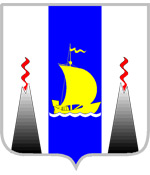
Sakhalin oblast map, Russia
Sakhalin oblast latest news and posts from our blog:.
14 April, 2024 / Beautiful Landscapes of Iturup Island .
28 November, 2022 / Abandoned Aniva Lighthouse on Sakhalin Island .
29 October, 2019 / Yuzhno-Sakhalinsk - the view from above .
14 July, 2017 / Amazing Nature of Iturup Island .
16 March, 2016 / Columnar Landscape of Cape Stolbchaty on Kunashir Island .
More posts..
News, notes and thoughts:
17 December, 2011 / The oil drilling platform "Kolskaya" capsized on Sunday, about 200 kilometers off the coast of Sakhalin. According to recent data, there were 67 people on board. Currently, 14 people were rescued .
History of Sakhalin Oblast
The first people came to Sakhalin Island approximately 250-300 thousand years ago. The modern history of the region began in the 17th century, when the first Russian explorers came to the Pacific coast. The south of Sakhalin and the Kuril Islands were inhabited by Ainu, the north of Sakhalin was inhabited by Nivkh.
In 1644, the first map of Sakhalin and the Kuril Islands was compiled. In 1689, the peace treaty between the Russian kingdom and China was signed in Nerchinsk. For the first time it defined the boundary between the two states. Russia had to leave the Amur region for almost a century and a half. As a result, Sakhalin was beyond Russian influence for a long time. In the mid-18th century, the Manchus troops landed on Sakhalin. The population of the island became dependent on China.
In 1806-1807, the first Russian-Japanese armed conflict took place in the southern Sakhalin and the Kuril Islands. October 20, 1806, N.A.Khvostov declared Sakhalin the Russian territory. In 1808, the Japanese restored ruined settlements in Sakhalin and Iturup.
In 1811, the Japanese garrison of the island of Kunashir took the Russian navigator V.M.Golovnin prisoner. He spent over 2 years in Japanese prison and was set free only after the Russian administration declared that N.A.Khvostov’s attacks were not legal.
More Historical Facts…
In 1850, G.I.Nevelsky raised the Russian flag in the lower Amur and declared it and Sakhalin the Russian territory. In 1855, the first Russian-Japanese treaty was signed in the town of Simoda. Simoda Treaty stated that the boundary between Russia and Japan was to be between the islands of Urup and Iturup. Sakhalin remained a co-ownership between the two countries.
In 1858, the first exiles were brought to Sakhalin. In 1869, Sakhalin was officially declared as a place of exile and a prison. In 1875, another Russian-Japanese treaty was signed in St. Petersburg. According to it, Japan renounced its rights to Sakhalin and received the Kuril Islands in return.
In June-July, 1905, the Japanese troops occupied Sakhalin. September 5, 1905, after the defeat of the Russian Empire during the Russian-Japanese War, a peace treaty was signed in Portsmouth (USA), according to which the southern part of Sakhalin became part of the Empire of Japan. In 1906, the Russian government cancelled exile and prison on Sakhalin. In 1907, the Japan government formed a governorship Karafuto on the territory of the southern Sakhalin.
On May 9, 1920, the Soviet power was declared in the northern Sakhalin. On April 22, 1920, about 2,000 Japanese soldiers landed in Alexandrovsk and seized power in the north of the island. This was followed by arrests and murders of supporters of the Soviet regime. On January 20, 1925, the “Convention on principal rules of the USSR and Japan interrelations” was signed in Beijing. It returned the northern Sakhalin to the USSR.
On April 13, 1941, the Soviet-Japanese Neutrality Pact was signed. On February 11, 1945, in Yalta, Stalin, Roosevelt and Churchill signed an agreement on conditions of the USSR entering the war against Japan. One of the conditions was the transfer of the southern Sakhalin and the Kuril Islands under the jurisdiction of the USSR.
On August 8, 1945, the USSR declared war on Japan. On August 11-25, 1945, there were clashes in the southern Sakhalin. On February 2, 1946, the southern Sakhalin and the Kuril Islands were declared the territory of the USSR. At the same time, Yuzhno-Sakhalinskaya oblast was formed on the territory of southern Sakhalin and the Kuril Islands. A new region became part of Khabarovsk krai.
In 1946-1948, the Japanese population of the southern Sakhalin and the Kuril Islands was repatriated. On September 8, 1951, a peace treaty with Japan was to be signed in San-Francisco. According to it, Japan renounced all rights and claims to the southern Sakhalin and the Kuril Islands. But the treaty didn’t say anything about whom these territories should belong. The Soviet delegation didn’t sign the treaty.
On October 19, 1956, the Soviet-Japanese declaration was signed in Moscow. It stated the end of the war between the USSR and Japan. The article #9 of the declaration implied negotiations on the peace treaty and included the consent of the Soviet Union to return Japan the islands of Khabomai and Shikotan after signing the agreement. In 1960, the Soviet government refused to fulfill the obligations of the article #9 of the Moscow agreement.
On September 1, 1983, a jet fighter of the Soviet Air Force shot down a South Korean passenger Boeing that entered Soviet airspace over the territory of Sakhalin, 269 passengers died.
Today, the peace treaty between Russia and Japan is still not signed. This territorial issue remains the major problem in relations between Russia and Japan to this day.
Beautiful nature of Sakhalin Oblast
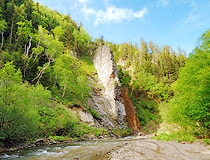
Nature of Sakhalin Oblast
Author: Semyonov Alexander
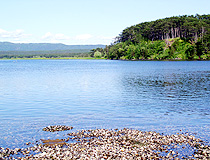
Lake in Sakhalin Oblast
Author: Sergey Kotelnikov
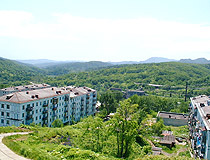
Hilly landscape of Sakhalin
Author: Podkovyrov Igor
Sakhalin Oblast - Features
Sakhalin Oblast is the only region in Russia, which is located on islands. It includes Sakhalin Island (76,600 sq. km.) with the neighboring small islands of Moneron and Tyuleniy, as well as the Kuril Islands (10,500 sq. km.).
Sakhalin is one of the largest islands in Russia, which stretches for 948 km from north to south. It is separated from the mainland by Tatar Strait, the width at the narrowest point, between the capes of Pogibi and Lazarev, is about 7 kilometers. The archipelago of the Kuril Islands stretches for 1,200 kilometers from north to south, between Kamchatka and Hokkaido.
The region is washed by the Sea of Okhotsk, the Sea of Japan and the Pacific Ocean. The unique geographical location of Sakhalin favors the development of international relations.
The climate is temperate, monsoon. The average temperature in January ranges from minus 6 (in the south) to minus 24 (in the north) degrees Celsius, in August - from plus 19 to 10 degrees Celsius respectively.
The main feature of the local nature is high seismic and volcanic activity. This is especially true for the Kuril Islands where there are 9 active volcanoes and earthquakes occur quite often.
Natural resources and economy of Sakhalin Oblast
Sakhalin Oblast is a place that combines a great raw materials potential with extreme conditions of its developing. In addition to biological resources provided by the seas, the region has large reserves of hydrocarbons.
The local population is not numerous, the infrastructure is not developed, except for Sakhalin. There is no stable year-round transport communication between different parts of the region (islands).
Sakhalin is specialized in fishery and its processing, forest and wood processing, pulp and paper industries. Oil, natural gas and coal are extracted here. It is the only region in Russia producing agar (also known as agar-agar) - a gelatinous substance obtained from seaweed.
Sakhalin is the third-largest producer of fish products in the Russian Far East. Seafood and timber are exported mainly to Japan, as well as to other Asia-Pacific countries.
Tourism in Sakhalin Oblast
Sakhalin Oblast has great potential for tourism development. Nature of Sakhalin is unique and beautiful. There are spa and thermal springs, deposits of curing mud, over 1,000 cultural and historical objects, volcanoes, waterfalls, monuments of archaeology, sites connected with culture of the natives.
The main tourism activities include rafting, climbing in the mountains (in particular Chekhov peak), hiking, snowboarding, skiing, cycling, caving, paragliding, windsurfing, year-round fishing, sea kayaking, scuba diving, ice climbing, kite surfing.
“Iljya Muromets”, the highest waterfall in Russia (141 meters), is located on Iturup Island, part of the Kuril Islands. Tyuleny Island, located east of Sakhalin, is a unique nature reserve with a rookery of fur seals.
Today, about 85-95% of foreign tourists come from Japan. They are interested in sightseeing and educational, environmental, fishing and nostalgic tourism.
Sakhalin oblast of Russia photos
Pictures of sakhalin oblast.
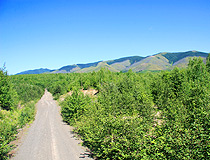
Sakhalin Oblast scenery
Author: Fedotov A.
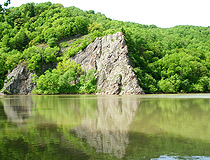
Lake in the Sakhalin region
Author: Dmitry Peskov
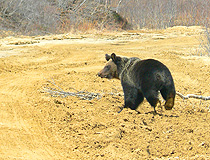
Bear in Sakhalin Oblast
Author: Alexander Alyuskin
On the coast in Sakhalin Oblast
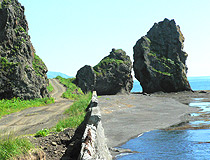
Rocks on the coast in Sakhalin Oblast
Author: Shulyak Alexander
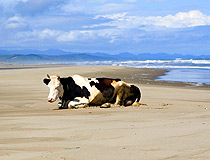
Just a cow resting on the beach in the Sakhalin region
Author: Joey Tucker
The questions of our visitors
- Currently 3.09/5
Rating: 3.1 /5 (166 votes cast)

IMAGES
COMMENTS
Trek Domane SL 5 is a step up from an entry-level carbon bike, featuring high-quality components and Trek's patented IsoSpeed frame. Trek's Domane SL 5 carbon road bike features its unique 500 Series OCLV Carbon frame with front and rear IsoSpeed to absorb shock and reduce fatigue. The IsoSpeed system is the result of years of research and ...
The new Domane is everything great about the old bike, plus lighter and quicker. The Takeaway: Trek's best road bike gets faster, lighter, quicker, and better. Weight: 19.7lb. (SL 5) to 16 lb ...
DESCRIPTION. Domane 5 Series is your cobble-tuned secret weapon in a ride-all-day race. IsoSpeed technology and Domane geometry give this carbon endurance race bike the winning edge. Comfort, Lightness, Handling, & Speed. None. I had the Trek Madone 5 Series for a year and a half and loved it.
The 2023 Trek Domane SL 5 Gen 4 is a bike that is designed for endurance rides and long-distance cycling. The bike's lightweight frame and comfortable riding position make it easy to ride for long hours without feeling fatigued. The bike's Shimano 105 groupset provides smooth shifting and a wide range of gears, making it easy to tackle ...
The Trek Domane SL 5 is a high-performance road bike designed for comfort and versatility on various terrains.
Pricing for the Domane is similar, starting at $1,799 for a 2 Series and rising to over $14,000 for a custom 6 Series Domane. For this review, Trek Australia supplied a Madone 5.9 and a Domane 5.9. The two bikes share the same price ($4,999) and essentially the same build kit (11-speed Ultegra Di2 with Bontrager wheels), but they are designed ...
How does the Trek Domane SL5 compare to other road bikes? Find out in this detailed review by BikeRadar experts.
Trek Domane SLR review. Oct 2022 · James Spender. The Domane is a tremendously smooth bike thanks to Trek's IsoSpeed rear damping system and high volume, 32mm tubeless tyres. ... 500 Series OCLV Carbon, front and rear IsoSpeed, internal storage, tapered head tube, internal cable routing, 3S chain keeper, DuoTrap S-compatible, mudguard mounts ...
The All-New Trek Domane AL Gen 4 Gets a Half-Pound Lighter with More Room for Tires. Sep 2023. ... Trek Domane SLR review. ... 500 Series OCLV Carbon, front & rear IsoSpeed, internal storage, tapered head tube, internal cable routing, 3S chain keeper, DuoTrap S compatible, fender mounts, flat mount disc, 142x12mm thru axle ...
Trek Domane SLR 9 2020 review. Dec 2019 · Stu Bowers. ... Somewhat heavy. Read Review. Show More Reviews. Geometry. Specs. Build. Frame: 500 Series OCLV Carbon, front & rear IsoSpeed, internal storage, tapered head tube, internal cable routing, 3S chain keeper, DuoTrap S compatible, fender mounts, flat mount disc, 142x12mm thru axle. BB ...
Trek Domane 5.2 - video review | BikeRadar
It's as much of an all-rounder as the man who took his third Flanders crown last spring. Specification Name: Domane 5.9 Dura Ace (15) Built by: Trek Price: £3300 / US$5150 / $5299. Features ...
Hitting the street for less than $2,800, the Domane 4.5 struck me as a steal, considering the high-end frame technology and the smart build kit. While it will likely be pitched to riders looking for a high-performance ride for centuries and gran fondos, the Domane is a race bike at heart that won't beat you up on the weekdays. Vital stats
Or, for just £1,000, there's the Domane 2.0, which shares a lot of the 5.9's top-notch genealogy. Verdict: A stunning bike. Amazing comfort coupled with a penchant for speed. If you want to get out and ride no matter what the terrain or conditions, this is the one - 90%. Contact : www.trekbikes.com.
The Trek Domane SL 5 Gen 4 features a lightweight 500 Series OCLV carbon fiber frame and rear IsoSpeed, which absorbs road vibrations and ensures a comfortable ride. Its integrated bike seat enhances both its appearance and riding feel. ... [BMC Roadmachine X Two Review] Trek Domane SL 5 Gen 4 vs. 2022 Bianchi Impulso - GRX 810. Bianchi ...
Srode. 3933 posts · Joined 2012. #5 · Jun 9, 2014. The seat mast and the components are the main differences between 4 and 5 series. The 6 series real difference is color options, although the frame is lighter than the 5 series marginally. I think the 5.2 is the sweet spot in the Domane line if you like the colors.
Trek Domane 5.9 Dura-Ace review | BikeRadar
Trek Domane 5.2 - video review. Apr 2015 · Warren Rossiter. Trek's Isospeed 'pivot' lets the seat tube flex for rear end plushness. . Read Review. Show More Reviews. Specs. Build. Frame: 500 Series OCLV Carbon, IsoSpeed, Ride Tuned seatmast, Power Transfer Construction, hidden fender mounts, E2 tapered head tube, BB90, performance ...
Max tire clearance is a quoted 700c x 38 mm. A new Domane SL frame weighs a quoted 1391 grams, 300 grams lighter than the previous Domane SL. Domane SL features a rear IsoSpeed decoupler to improve seated comfort, though it is no longer adjustable. Domane SL is available in seven sizes to fit riders between 4'11" to 6'5".
The climate in Yuzhno-Sakhalinsk is quite mild, there are no severe frosts in winter, and heat in summer. The coldest month is January with an average temperature of about minus 12 degrees Celsius. The warmest month is August (plus 17 degrees Celsius). Clear and dry weather sets in early September - the best time to visit Sakhalin.
A Journey Through Giant Burdocks, Wild Bears, and the Echoes of Ancient Japanese Temples From the most dreaded place of exile in the Russian Empire to a Japanese industrial base and one of the most attractive and inaccessible places for domestic tourism in Russia. An island that was Russian, then Japanese, and then Russian again… Read More »Sakhalin: Your Essential Guide to Russia's ...
Yuzhno-Sakhalinsk - Overview. Yuzhno-Sakhalinsk is a city located in the southern part of Sakhalin Island in the Far East of Russia, the administrative center of Sakhalin Oblast. The population of Yuzhno-Sakhalinsk is about 201,700 (2022), the area - 164 sq. km. The phone code - +7 4242, the postal codes - 693000-693904.
Sakhalin Oblast - Overview. Sakhalin Oblast is one of the easternmost regions of Russia and the only region completely located on islands (Sakhalin Island and the Kuril Islands), part of the Far Eastern Federal District. Yuzhno-Sakhalinsk is the capital city of the region. The population of Sakhalin Oblast is about 484,200 (2022), the area - 87,101 sq. km.